Backgrounder
The PRC Twitter List: The Rise of China on Twitter
“Twittering China’s stories well” – about the surge of Chinese official accounts on Twitter.
Published
4 years agoon
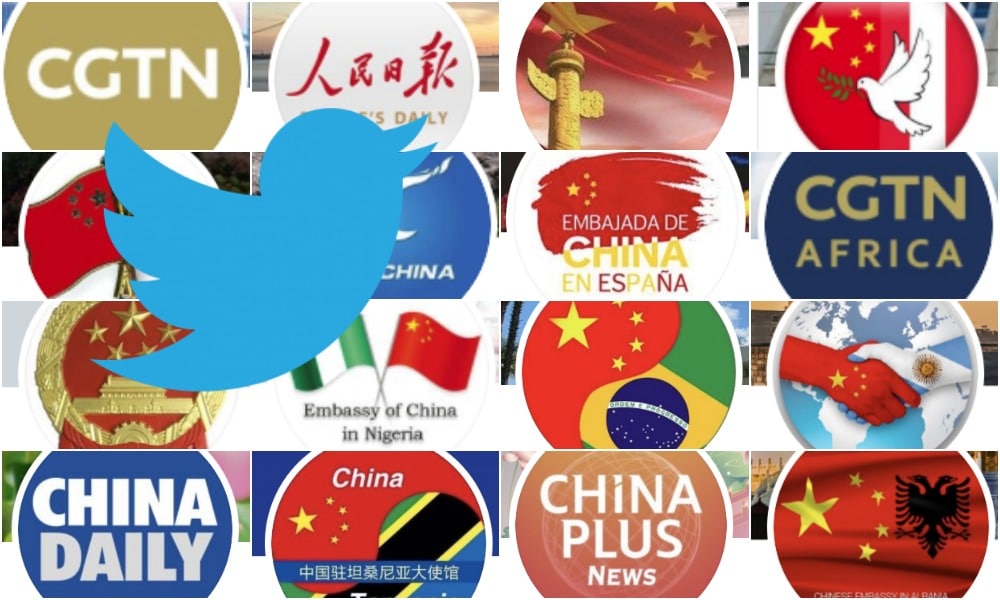
PREMIUM CONTENT
Over the past year, there’s been more media coverage on the growing influence of China on global media. When it comes to social media, Twitter has seen a significant surge in accounts representing Chinese official media, diplomatic missions, and state organizations. What’s on Weibo gives an overview of these Twitter accounts and the rise of China on Twitter.
Apart from the countless Chinese official media and government accounts on China’s domestic social media platform Weibo, there is now an increasing number of Beijing-linked accounts that have gone beyond the Great Firewall and have set out for Twitter.
Official Chinese accounts have become more present and more active on foreign social media over the past few years, and we have found that there has been a significant surge of new official accounts arriving on Twitter in 2019 and in early 2020.
Within China, Weibo and WeChat have become increasingly relevant when it comes to public diplomacy. For years now, foreign embassies, media, pundits, and government organizations from all over the world are active on Chinese social media platforms.
The growing ubiquity of digital diplomacy is unsurprising: social media platforms are a low-cost and convenient tool for engaging with local audiences for public diplomacy purposes.
In our article “Digital Diplomacy: These Foreign Embassies Are Most (Un)Popular on Weibo” (2016), we explored the popularity of foreign embassies on Sina Weibo. There is even a term for this kind of diplomacy via Weibo: “Weiplomacy.”
While foreign actors are active on Weibo and other platforms, Chinese actors are also increasingly active in the English-language social media sphere.
The use of Twitter for diplomacy uses is not new, nor is it unique to China. The term used for public diplomacy strategies on Twitter is ‘Twiplomacy,’ and government officials from as many as 178 countries have been using Twitter for diplomatic purposes (Guo et al 2019, 563-564).
CHINA’S TWIPLOMACY
The use of Twitter for Chinese government purposes has received more media attention recently. In June of this year, news came out that Twitter suspended more than 23,000 ‘fake’ accounts for allegedly being linked to the Chinese Communist Party and spreading false information and promote Party narratives to undermine the Hong Kong protests and/or to counter criticism of Beijing’s handling of COVID-19 (Washington Post, 2020).
This development is somewhat surprising, as previous studies have found no evidence of these kinds of automated processes on Twitter as part of Chinese international propaganda efforts (Bolsover & Howard 2019). Noteworthy enough, it was previously found that those using bot activities on the platform to manipulate information about China and Chinese politics were actually anti-China groups (ibid., 2076).
What is clear from the recent growing presence of Chinese state-related accounts on Twitter, is that online political communication promoting Chinese interests is often manually done by real accounts and real people, e.g. state employees, as part of their regular jobs.
China’s shift from traditional forms of public diplomacy and propaganda to more innovative and digital ones has been ongoing for years. Since Xi Jinping’s ascension to power, the media strategy of “telling China’s story well” started to become more prominent in foreign diplomacy efforts (Shambaugh 2020, 17).
But also before this time, between 2009 and 2011, there was a heightened focus on China’s international media presence, with the government spending billions on a global media plan, mainly executed via media agencies such as Xinhua, China Daily, CCTV, and China Radio International (Bolsover & Howard 2019, 2065; Huang & Wang 2020, 118).
The One Belt, One Road summit in May of 2017 was an important digital media moment as Chinese state media and official social media accounts shared new kinds of promotional campaigns targeted at domestic and foreign audiences (see our article). In that same year, social media also played a major role in the propagation of PRC’s “New Era,” which was promoted via short videos, cartoons, and gifs (also see this article).
Whereas China’s foreign online public diplomacy previously mostly seemed to focus on promoting the positive image of China as a peaceful nation (the 2020 study by Huang and Wang on ‘panda engagement’ analyzes the panda-themed tweets of official media accounts on Twitter), we have seen a different trend in China’s digital public diplomacy over the past year.
Yes, there are still panda tweets. But Twitter is also used more and more to also aggressively defend China’s image and attacking others while spreading official narratives on contentious issues such as the South China Sea dispute, US-China trade war, alleged human rights violations in Xinjiang, the Hong Kong protests, and China’s handling of the COVID19 outbreak.

Example of public diplomacy on Twitter, via Ministry of Foreign Affairs @MFA_China (screenshot by What’s on Weibo).
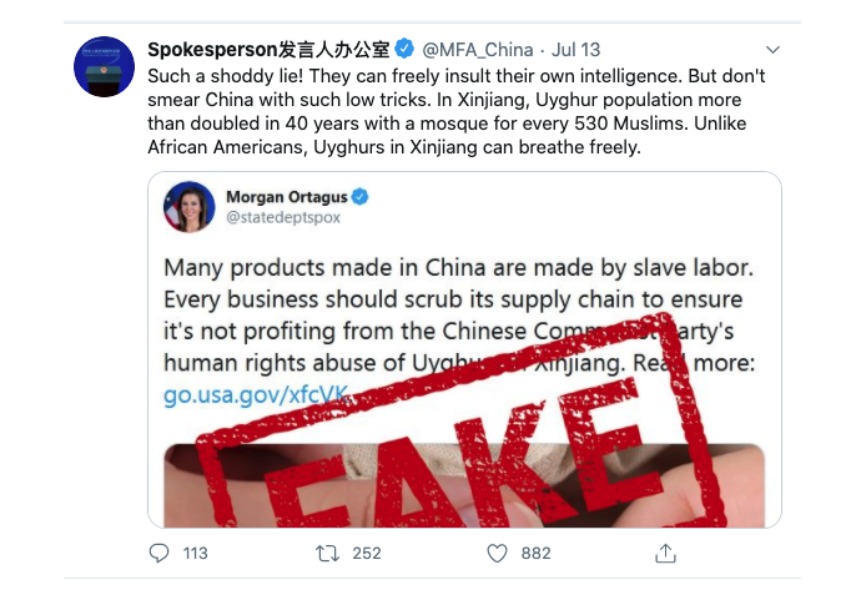
This is not always done in the most sophisticated way. One noteworthy example is that of the China State Council Information Office, tweeting under the (unverified) handle of @chinascio. In 2016 and early 2017, the account repeatedly responded to other twitterers using slang terms such as “dude” or “bro” (“better for you to learn a whole picture of China, dude“), causing hilarity among Twitter users. James Griffith (@jgriffiths) even covered the issue on the CNN website, highlighting the account’s use of the “truth ain’t lie dude” phrase. The controversy was also covered by Chinese Huanqiu Online (Global Times) media outlet.



Other official accounts, such as People’s Daily or that of the Ministry of Foreign Affairs have also sent out tweets in the past that seemed somewhat out of character, using common slang terms such as “dude” or “LOL.”
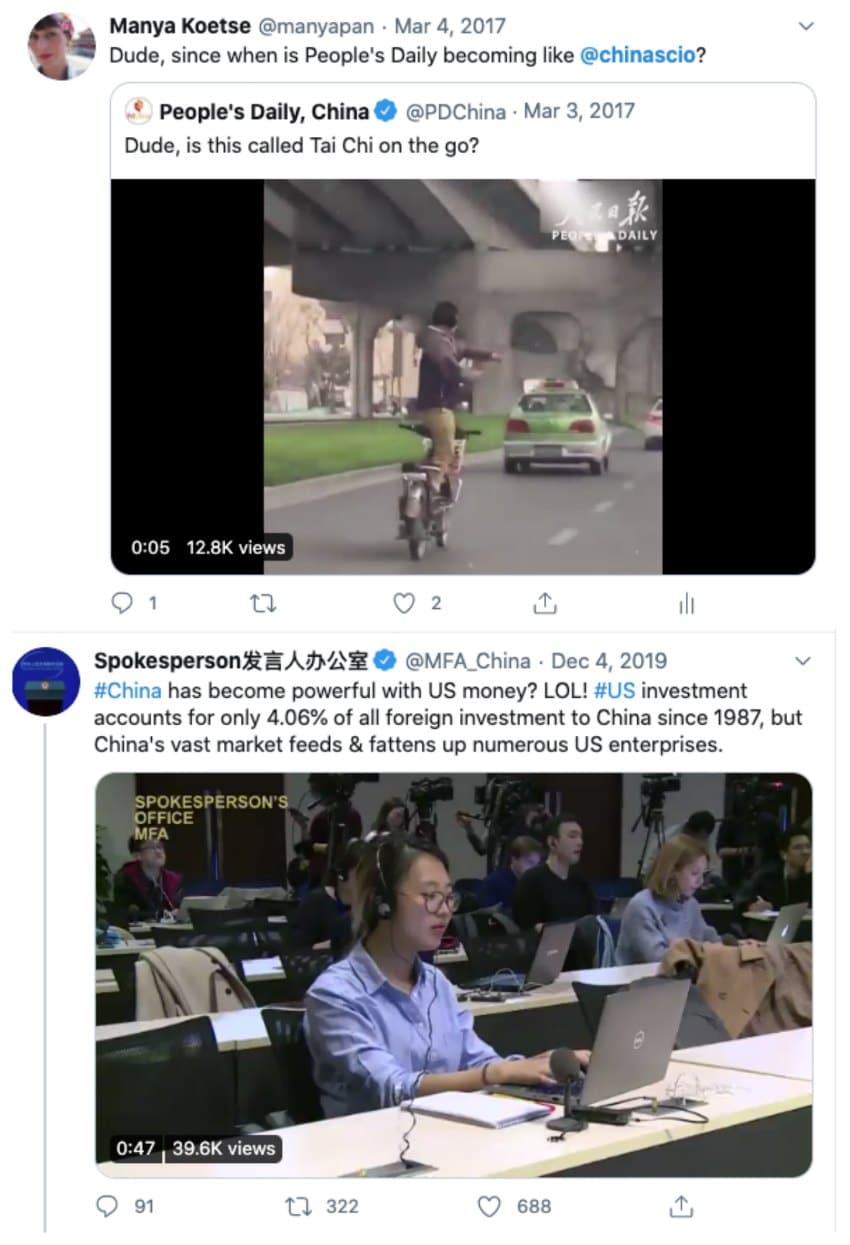
Over the past two years, Chinese Twitter strategies seem to have become more sophisticated, with an increasing number of state media, diplomatic missions and government organizations joining the American social media platform.
There are, however, new rows coming up over the Twitter use of Chinese officials. In May of 2020, China’s embassy in Paris sent out a tweet portraying a grim reaper – dressed in US flag while holding a scythe with the Star of David – knocking on the door of Hong Kong, with a text saying: “Who’s next?”

Screenshot as posted by Isaac Stone Fish on Twitter
@isaacstonefish
The embassy soon deleted the tweet and released a statement saying its Twitter was hacked. It was not the first time the Embassy came under scrutiny for its Twitter use; the Chinese Ambassador to France was summoned to the Ministry for Europe and Foreign Affairs in April for a series of other provocative tweets during the coronavirus crisis.
The French Minister of Europe and Foreign Affairs stated that the tweets were not “keeping with the quality of the bilateral relationship between our two countries.”
Although Chinese state media outlet Global Times wrote about the official Twitter account that the “Chinese Embassy’s humorous satirical taste delights social media users,” these kinds of online altercations show that China’s global diplomatic offense on Twitter can lead to offline clashes, or rather, that online and offline diplomacy are no longer separate worlds. Digital diplomacy is thus not necessarily just ‘digital diplomacy’ – it’s diplomacy, period.
TWITTER USE IN CHINA
That there is a growing presence of Chinese official accounts on Twitter does not mean that there is also growing freedom for Chinese web users to use the platform from within mainland China.
Twitter has been blocked in China since June 2009, and is inaccessible unless web users make use of software to circumvent censorship and to jump over the Great Firewall of China. Only a small percentage of Chinese web users do so.
According to a survey by political scientist Daniela Stockmann, cited in the New York Times, some 0.4 percent of China’s internet users, roughly 3.2 million people, use Twitter.
Not only is Twitter blocked in China – Chinese nationals who post critical views on the platform could end up in trouble. In his 2019 New York Times article, Paul Mozur explored the Beijing crackdown of Twitter, writing that a growing number of Chinese twitterers are questioned or even detained for their activities on Twitter.
Chinese activists quoted in the article talk about being advised to remove tweets, and also about being interrogated, threatened, and physically restrained over their Twitter behavior.
Telling – or rather, Twittering – China’s stories well is a key mission in China today. But who Twitters these stories in what ways is strictly controlled.
ABOUT THIS LIST
To give you an idea of China’s new Twitter diplomacy and to provide insight into the ‘official’ accounts that are active on Twitter today, we have compiled the list below for reference, consisting of some 280 relevant accounts in total.
This list only covers accounts representing mainland Chinese state media, diplomatic missions, and other government & state organizations. It leaves out individual Chinese Twitter users unless they are officially representing Chinese media and/or state and government organizations.
The number of followers for each account is recorded at the time of writing between July 11-20. Accounts are listed going from most number of followers on top.
This list is by no means complete. We might have overseen official accounts (please let us know), and it has left out, for example, the many different accounts run by Confucius Institutes worldwide, and also does not list the state-owned enterprises that are active on Twitter.
This list has been compiled manually by What’s on Weibo – it is not an official list by any means. Please note that we have included accounts that have not been verified by Twitter, as most of these accounts do not have the verified ‘v’ status (yet) – the fact that Twitter’s verified account program has been on hold for a long time might have to do with this.
Although caution is thus advised, we currently have no reason to assume that any of the accounts in this list do not belong to the person or organization they say they represent in their bio.
Contributing to this is the fact that these accounts are also followed by other official accounts that have already been verified. If an account is officially verified, we have tagged it as “VERIFIED ACCOUNT.”
In writing personal names, we stick to the way the person presents their name on Twitter. Mostly, they state their last name first, followed by the given name, but sometimes they use the Western style and turn it around.
This list is not necessarily focused on accounts tweeting in English. Many of the accounts tweet in (traditional) Chinese or other languages including Spanish, Japanese, German, or French (both media and accounts of diplomatic missions).
NOTEWORTHY FINDINGS
The first official Chinese media accounts to join Twitter are Global Times, CCTV, China Daily, and China Plus News (CRI). They all joined from April-Nov 2009, three years after the founding of Twitter, and in the same year that the platform was blocked in mainland China. This was also the year that the Chinese government under Hu Jintao reportedly spent $8.7 billion on a foreign media expansion project.
From that moment on, Chinese media accounts slowly start joining Twitter. Around the 2012-2013 period, when President Xi Jinping introduces the idea of promoting China in the digital age by “telling China’s stories well,” accounts such as China News, Xinhua News, Guangming Daily, and CGTN all join Twitter. Region-specific accounts, including People’s Daily Arabic, Xinhua Spanish, or CGTN Africa, also all join around this period.
Around the year 2017, we see a small surge in Chinese media, government, and city accounts joining Twitter. This is the year that China’s Belt and Road propaganda machine is running at full speed. It is also the year of the 19th National Congress, when Chinese media focus on the message of “supporting China’s New Era.”
But the most noteworthy first surge of Chinese ‘official’ government-related and diplomatic accounts takes place in 2019 at the time of the Hong Kong Protests. While mass demonstrations and violent clashes take place in Hong Kong, we see a total of 35 new official diplomatic/government accounts joining Twitter from July to November of 2019.
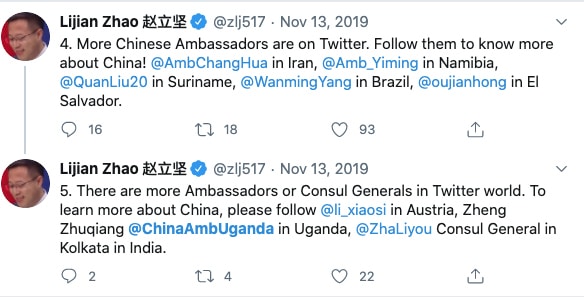
The second rise of Chinese official accounts on Twitter takes place in the period of January to March 2020, when a total of 47 new official diplomatic/government accounts join the platform during the international COVID19 crisis.
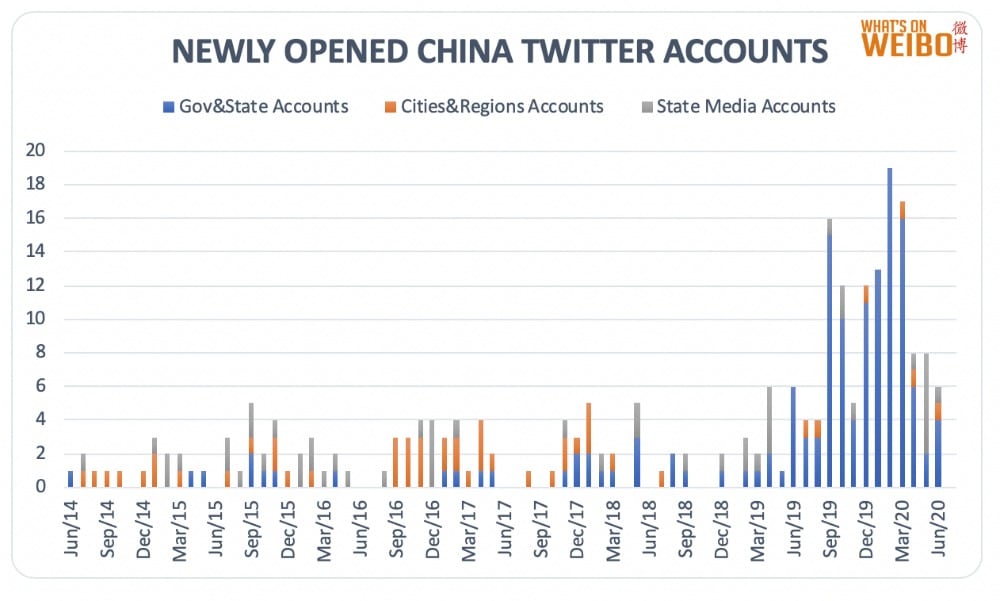
There also seems to be a clear shift in China’s “Twiplomacy” regarding the overall tone of Twitter posts. Whereas most of the city and regional accounts – arriving on Twitter since 2012 – engage in “panda twiplomacy” and promote China as a harmonious leader and beautiful tourist destination, many diplomatic and media accounts that joined Twitter later shifted tones in addressing international criticism or clarifying China’s stance in main issues concerning the international community, including the South China Sea issue and the US-China trade war.
Over recent months and weeks, the accounts of many diplomats and other accounts in this list have tweeted out images/information sheets, articles, or videos on “What is True and What is False” regarding international media reports on China’s alleged human rights violations, Hong Kong National Security Law, and COVID19 pandemic. These kinds of “true” and “false” images are often produced by Chinese media outlets and then retweeted by many embassy and/or diplomatic accounts and other media accounts. 
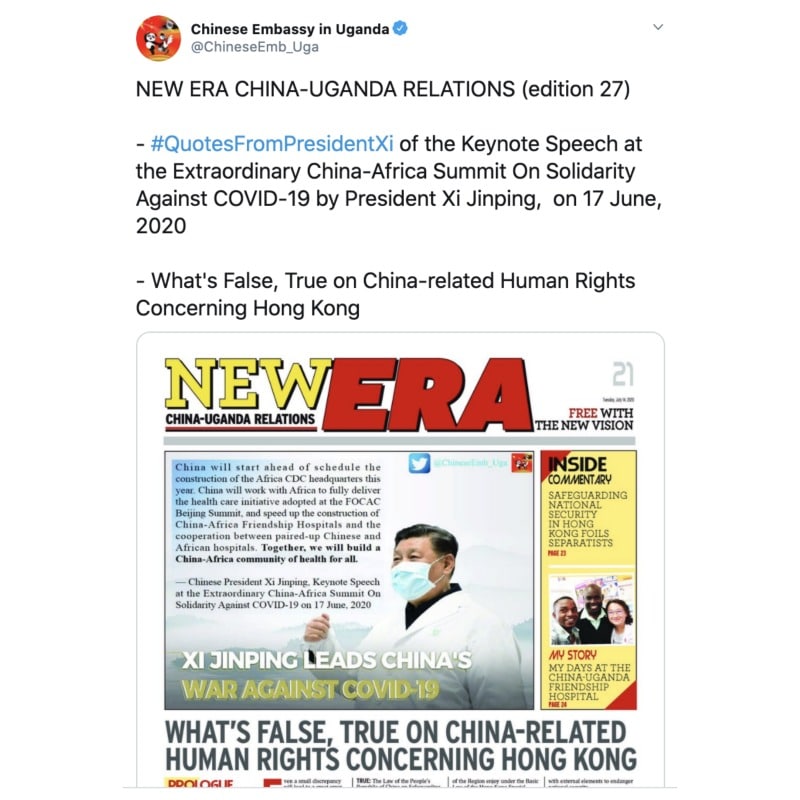
We also found that this list of Twitter accounts does not mirror Weibo at all – many of the accounts in this list have no presence on Weibo and thus were solely created to speak to an overseas audience.
The accounts in this list amplify each other by following each other and through retweeting. For example, the @MFA_China account (Ministry of Foreign Affairs) has over 178k followers on Twitter, and often retweets the tweets by other official accounts. The diplomatic, media, and city/region accounts often follow each other.
Here’s our list! (First version July 21, 2020, updated by adding three more diplomats on July 22, 2020).
Update August 7 2020: As of August 6, 2020, Twitter implemented government and state-affiliated media account labels on its platform. The label appears on the profile page of the relevant Twitter account, as shown in the example below.
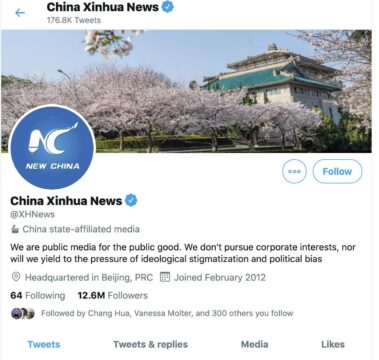
LIST OF CHINA ACCOUNTS ON TWITTER
CHINA GOVERNMENT & STATE RELATED ACCOUNTS

CHINA DIPLOMATIC MISSIONS
Chinese Embassy in Pakistan
@CathayPak, 104.8K followers
(Joined Sep 2015)
Chinese Embassy in Brazil
@EmbaixadaChina, 72.8K followers
(Joined May 2018)
Chinese Embassy in Japan 中華人民共和国駐日本国大使館
@ChnEmbassy_jp, 69K followers
(Joined April 2014)
Chinese Embassy in US
@ChineseEmbinUS, 45.6K followers
(Joined June 2019)
Chinese Mission to UN
@Chinamission2un, 39.8K followers
VERIFIED ACCOUNT (Joined April 2015)
Chinese Embassy in Italy
@AmbCina, 33K followers
VERIFIED ACCOUNT (Joined May 2018)
Chinese Embassy in Spain
@ChinaEmbEsp, 26.3K followers
VERIFIED ACCOUNT (Joined Sep 2019)
Chinese Embassy in Turkey
@ChinaEmbTurkey, 28.5K followers
VERIFIED ACCOUNT (Joined Oct 2015)
Chinese Embassy in France
@AmbassadeChine, 24.1K followers
(Joined August 2019)
Chinese Embassy to Yemen
@ChineseEmbtoYEM, 18.2K followers
VERIFIED ACCOUNT (Joined September 2019)
Mission of the People’s Republic of China to the EU
@ChinaEUMission, 16K followers
VERIFIED ACCOUNT (Joined Sep 2013)
Chinese Embassy in UK
@ChineseEmbinUK, 13.7K followers
VERIFIED ACCOUNT (Joined Nov 2019)
Chinese Embassy in the Philippines
@Chinaembmanila, 12.2K followers
(Joined Feb 2017)
Chinese Embassy in South Africa
@ChineseEmbSA, 12K followers
(Joined Sep 2019)
Chinese Embassy in Kenya
@ChineseEmbKenya, 6662 followers
(Joined March 2019)
Chinese Embassy in Canada
@ChinaEmbOttawa, 6492 followers
(Joined June 2014)
Chinese Embassy in Tanzania
@ChineseEmbTZ, 6,064 followers
(Joined Dec 2019)
Chinese Embassy in Zimbabwe
@ChineseZimbabwe, 5,856 followers
(Joined Sep 2018)
Chinese Consulate General in Istanbul
@chinaconsulist, 4778 followers
(Joined Feb 2020)
Chinese Embassy in Congo
@AmbCHINEenRDC, 4654 followers
VERIFIED ACCOUNT (Joined Jan 2020)
Chinese Embassy in Uganda
@ChineseEmb_Uga, 3943 followers
VERIFIED ACCOUNT (Joined Jan 2018)
Chinese Embassy in Venezuela
@Emb_ChinaVen, 3785 followers
(Joined September 2019)
Chinese Embassy in Somalia
@ChineseSomalia, 3424 followers
(Joined June 2019)
Chinese Embassy in Argentina
@ChinaEmbArg, 3212 followers
(Joined March 2020)
Chinese Embassy in Sri Lanka
@ChinaEmbSL, 2920 followers
(Joined March 2020)
Chinese Embassy in Ethiopia
@ChinaEmbAddis, 2809 followers
(Joined December 2019)
China Mission Geneva
@ChinaMissionGva, 2574 followers
VERIFIED ACCOUNT (Joined May 2015)
Chinese Embassy in Hungary
@ChineseEmbinHU, 2527 followers
VERIFIED ACCOUNT (Joined Oct 2019)
Permanent Mission of China in Vienna
@ChinaMissionVie, 2344 followers
VERIFIED ACCOUNT (Joined Oct 2019)
Chinese Embassy in Germany
@ChinaEmbGermany, 2339 followers
VERIFIED ACCOUNT (Joined December 2019)
Chinese Consulate General in Chicago
@ChinaConsulate, 2315 followers
VERIFIED ACCOUNT (Joined Feb 2019)
Chinese Embassy in the Republic of Chad
@ambchinetchad, 2272 followers
VERIFIED ACCOUNT (Joined Sep 2019)
Chinese Embassy in Iraq
@ChinaIraq, 2187 followers
VERIFIED ACCOUNT (Joined January 2020)
Chinese Embassy in Ireland
@ChinaEmbIreland, 2157 followers
(Joined Feb 2020)
Chinese Embassy in Poland
@ChinaEmbPoland, 2102 followers
(Joined July 2019)
Chinese Embassy in Grenada
@ChinaEmbGrenada, 2033 followers
VERIFIED ACCOUNT (Joined Oct 2019)
Chinese Embassy in Kazakhstan
@ChinaEmbKazakh, 1957 followers
VERIFIED ACCOUNT (Joined Sep 2019)
Chinese Embassy in Burundi
@AmbChineBurundi, 1818 followers
(Joined June 2019)
Chinese Embassy in Guinea 中国驻几内亚大使馆
@chine_guinee, 1769 followers
(Joined Sep 2019)
Chinese Embassy in Slovenia
@ChinaEmSlovenia, 1632 followers
(Joined Dec 2017)
Chinese Embassy in Mali
@Chine_au_Mali, 1452 followers
(Joined Aug 2018)
Chinese Consulate General in Calgary
@ChinaCGCalgary, 1442 followers
VERIFIED ACCOUNT (Joined Dec 2019)
Chinese Embassy in Austria
@chinaembaustria, 1391 followers
VERIFIED ACCOUNT (Joined Jan 2020)
Chinese Embassy in Colombia
@china_embajada, 1343 followers
VERIFIED ACCOUNT (Joined Feb 2020)
Chinese Embassy in Jordan
@ChineseembassyJ, 1321 followers
(Joined Sep 2019)
Chinese Embassy in Angola
@ChinaEmbAngola, 1391 followers
VERIFIED ACCOUNT (Joined Jan 2020)
Chinese Embassy in Papua New Guinea
@ChineseEmb_PNG, 1344 followers
VERIFIED ACCOUNT (Joined Feb 2020)
Chinese Embassy in Samoa 中国驻萨摩亚大使馆
@chinaandsamoa, 1187 followers
(Joined September 2019)
Chinese Embassy in Liberia
@ChineseLiberia, 1163 followers
VERIFIED ACCOUNT (Joined December 2019)
Chinese Embassy in Cameroon
@AmbChineCmr, 1130 followers
VERIFIED ACCOUNT (Joined Dec 2019)
Consulate-Generale of China in Rio de Janeiro
@ConsulChinaRJ, 1119 followers
VERIFIED ACCOUNT (Joined December 2019)
Consultate General of People’s Republic of China in Nagoya
@ChnConsulateNgo, 1071 followers
(Joined Feb 2020)
Chinese Embassy in Albania
@ChinaembassyT , 1023 followers
(Joined April 2019)
Chinese Embassy in Belarus 中国驻白俄罗斯大使馆
@ZhongBai2020, 975 followers
(Joined Jan 2020)
Consulate General of China in Barcelona 中国驻巴塞罗那总领馆
@ConsulChinaBcn, 968 followers
VERIFIED ACCOUNT (Joined Feb 2020)
Chinese Embassy in Nigeria
@china_emb_ng, 946 followers
(Joined Sep 2019)
Chinese Embassy in Denmark
@ChinaInDenmark, 904 followers
(Joined May 2017)
Chinese Embassy in the Slovak Republic 中国驻斯洛伐克使馆
@ChinaEmbSVK, 867 followers
VERIFIED ACCOUNT (Joined Feb 2020)
Chinese Embassy in Peru
@ChinaEmbPeru, 799 followers
(Joined Feb 2020)
Chinese Embassy in Suriname
@CHNEmbSuriname, 793 followers
(Joined Sep 2019)
Consulate of China in Niigata 中華人民共和国駐新潟総領事館の新ちゃん
@ChnConsulateNgt, 737 followers
(Joined March 2020)
Consulate General of China in Jeju
@jejuZLG, 736 followers
VERIFIED ACCOUNT (Joined October 2019)
Consulate General of the People’s Republic of China in Dubai
@CGPRCinDubai, 724 followers
VERIFIED ACCOUNT (Joined Dec 2019)
Consulate General of China in Fukuoka 中華人民共和国駐福岡総領事館
@ChnConsulateFuk, 722 followers
(Joined April 2020)
Chinese Embassy in Russia
@ChineseEmbinRus, 673 followers
(Joined Feb 2020)
Chinese Embassy in Tonga 中国驻汤加大使馆
@embassy_chinese, 611 followers
(Joined Nov 2019)
Chinese Embassy in Czech Republic
@ChineseEmbinCZ, 502 followers
(Joined Feb 2020)
Chinese Embassy in Ghana
@ChinaEmbinGH, 478 followers
(Joined March 2020)
Chinese Embassy in Djibouti
@ChineAmbDjibout, 424 followers
(Joined April 2020)
Consulat Général de Chine à Lyon
@China_Lyon, 280 followers
(Joined March 2020)
Embassy of China in the Netherlands
@ChinaEmbNL, 269 followers
(Joined June 2020)
Chinese Consulate General in Johannesburg
@ChnConsulateJhb, 241 followers
(Joined Oct 2019)
Chinese Consulate General in Sydney
@ChinaConSydney, 227 followers
(Joined April 2020)
Chinese Embassy in Serbia
@EmbChina_RS, 216 followers
(Joined May 2020)
Consulate-General of China in Strasbourg
@consulat_de, 203 followers
(Joined Feb 2020)
Chinese Consulate General in San Francisco
@ConsulateSan, 131 followers
(Joined March 2020)
Chinese Consulate General in Edinburgh
@chinacgedi, 110 followers
(Joined Feb 2020)
Chinese Consulate General in Belfast 中国驻贝尔法斯特总领事馆
@CCGBelfast, 39 followers
(Joined March 2020)
CHINESE AMBASSADORS AND DIPLOMATS
Cui Tiankai, @AmbCuiTiankai
Chinese Ambassador to the US, 79.2K followers
VERIFIED ACCOUNT (Joined June 2019)
Sun Weidong, @China_Amb_India
Chinese Ambassador to India, 75.8K followers
VERIFIED ACCOUNT (Joined Dec 2017)
Liu Xiaoming, @AmbLiuXiaoMing
Chinese Ambassador to the UK, 67.8K Followers
(Joined Oct 2019)
Yang Wanming, @WanmingYang
Ambassador of the People’s Republic of China to the Federative Republic of Brazil, 47.7K followers
VERIFIED ACCOUNT (Joined Nov 2015)
Hou Yanqi, @PRCAmbNepal
Ambassador of the People’s Republic of China to Nepal, 43.7K Followers
(Joined June 2019)
Chen Weiqing, @AmbChenWeiQing
Ambassador of China in Saudi Arabia , 33.3K followers
(Joined July 2019)
Chang Hua, @AmbChangHua
Ambassador of China to the Islamic Republic of Iran, 16.6K followers
(Joined Oct 2019)
Wei Qiang 魏强 , @weiasecas
Chinese Ambassador to Panamá, 15.9K followers
(Joined Nov 2017)
Zhang Heqing, @zhang_heqing
Cultural Counsellor, Director of China Cultural Center in Pakistan, 15.2K followers
(Joined May 2020)
Zhang Run, @EmbZhangRun
Chinese Ambassador to Dominican Republic, 12.1K followers
(Joined Dec 2018)
Zhang Lizhong, @AmbassadorZhang
Chinese Ambassador to Maldives, 11.8K followers
(Joined June 2019)
Wang Yu 王愚, @ChinaEmbKabul
Chinese Ambassador to Afghanistan, 11.2K followers
(Joined Jan 2017)
Li Xiaosi, @li_xiaosi
Chinese Ambassador to Austria, 11.1K followers
(Joined Sep 2019)
Deng Xijun, @China2ASEAN
Ambassador of the People’s Republic of China to ASEAN, 10.3K followers
(Joined Jan 2020)
Chen Bo, @AmbChenBo
Ambassador of China to Serbia, 9531 followers
(Joined March 2020)
Zha Liyou 查立友, @ZhaLiyou
CG of China in Kolkata 中国驻加尔各答总领事, 9935 followers
VERIFIED (Joined August 2019)
Mu Xiaodong 沐小东, @Xiaodong_Mu
Diplomat and Consul of Chinese Embassy in Myanmar, 8086
(Joined April 2016)
Zhang Yiming, @Amb_Yiming
Ambassador of China to the Republic of Namibia, 7467 followers
VERIFIED ACCOUNT (Joined Sep 2019)
Guo Shaochun, @China_Amb_Zim
Chinese Ambassador to Zimbabwe, 7434 followers
(Joined April 2019)
Liao Liqiang, @AmbLiaoLiqiang
Chinese Ambassador to Egypt, 7232 followers
VERIFIED ACCOUNT (Joined Dec 2019)
Li Bijian 李碧建, @libijian2
Consul General of China to Karachi, 7011 followers
(Joined January 2020)
Ji Rong, @ChinaSpox_India
Spokesperson of Chinese Embassy in India, 6330 Followers
(Joined March 2020)
Quan Liu @AmbLiuQuan
Ambassador of the People’s Republic of China to the Republic of Suriname, 5814 followers
(Joined Sept 2019)
Wang Kejian, @ChinainLebanon
Chinese Ambassador to Lebanon, 5752 followers
VERIFIED ACCOUNT (Joined Feb 2020)
Zhu Liying (朱立英), @LiyingZHU1
Chinese Ambassador to Mali, 5593 followers
(Joined August 2019)
Ou Jianhong, @oujianhong
Embajadora de China in El Salvador, 4619 followers
(Joined August 2018)
Feng Biao, @AmbFengBiao
Chinese Ambassador To Syria, 4630 followers
(Joined March 2020)
Liu Guangyuan, @AmbLiuGuangYuan
Chinese Ambassador to Poland, 3867 followers
(Joined March 2020)
Xu Hong, @PRCAmbNL
Chinese Ambassador to the Netherlands, 3485 followers
(Joined Nov 2019)
Zhu Jing 朱京, @Amb_ZhuJing
Ambassador of People’s Republic of China to Congo, 3360 followers
VERIFIED ACCOUNT (Joined Jan 2020)
Chen Xu, @Amb_ChenXu
Chinese Ambassador, Permanent Representative to UN office in Geneva, 3171 followers
VERIFIED ACCOUNT (Joined Dec 2019)
Zhang Jun, @ChinaAmbUN
China’s Permanent Representative to the UN, 3013 followers
(Joined Feb 2020)
Liu Yuxi, @Ambassador_Liu
Chinese Ambassador to the AU and the UNECA, 2787 followers
VERIFIED ACCOUNT (Joined October 2019)
Zhao Yongchen, @DrZhaoyongchen
Chinese Ambassador to Grenada, 2416 followers
VERIFIED ACCOUNT (Joined July 2019)
Huang Xingyuan, @AmbassadorHuang
Chinese Ambassador to Cyprus, 2069 followers
(Joined Feb 2020)
Cao Yi (Abou Wassim), @CAOYI170610
Consul, Embassy of China in Lebanon, 2015 followers
(Joined May 2018)
Zhang Ping, @CGZhangPingLA
Official Twitter for Consul General of the People’s Republic of China in Los Angeles, 1642 followers
VERIFIED ACCOUNT (Joined Nov 2019)
Dong Zhihua, @Dong_zhihua
WA Consul General, 1607 followers
(Joined Sep 2019)
Lin Jing 林静, @CGCHINA_CPT
Chinese Consul General in Cape Town, 1451 followers
(Joined March 2020)
Cao Zhongming, @ChinaAmbBelgium
Chinese Ambassador to the Kingdom of Belgium, 1429 followers
(Joined Dec 2019)
Liu_Hongyang, @LiuHongyang4
Ambassador of China to Malawi, 1265 followers
(Joined Feb 2018)
Zheng ZhuQiang, @ChinaAmbUganda
Ambassador of China to Uganda, 1163 followers
(Joined March 2018)
Li Li, @AmbassadeurLiLi
Ambassador of China to Marocco, 1085 followers
(Joined Jan 2020)
Zhao Qinghua, @Dr_ZhaoQinghua
Consul General of China in Zurich and for the Principality of Liechtenstein, 765 followers
VERIFIED ACCOUNT (Joined Feb 2020)
Li Yang, @CGChinaLiYang
Consule-General China in Rio de Janeiro, 727 followers
(Joined March 2020)
Yan Xiusheng 延秀生, @YXiusheng
Chinese Ambassador to Barbados, 614 followers
(Joined April 2020)
Chinese Embassy Bangkok, @chineseembassy1
Ambassador of the People’s Republic of China to Thailand, 567 followers
(Joined May 2019)
Fang Yi @FangYi85320692
Spokesperson & Head of Political Office of the Chinese Embassy in Uganda, 550 followers
(Joined Jan 2018)
Gu Wenliang 顾文亮, @GuWenliang
Agricultural Commissioner, Chinese Embassy in the Islamic Republic of Pakistan, 527 followers
(Joined Feb 2020)
Lijun Xing 邢立军 @xing_lijun
Chinese Diplomat in Pakistan, 514 followers
(Joined April 2017)
Lei Kezhong, @AmbassadorLei
Chinese Ambassador to Lesotho, 494 followers
(Joined March 2020)
Zhou Jian, @AmbZhouJian
Chinese Ambassador to the State of Qatar, 452 followers
(Joined Feb 2020)
Li Song 李松, @Amb_LiSong
Chinese Ambassador for Disarmament Affairs, Deputy Permanent Representative to UN Office in Geneva, 437 followers
VERIFIED ACCOUNT (Joined June 2020)
Du Xiaohui, @GeneralkonsulDu
Generalkonsul der VR China in Hamburg, 341 followers
VERIFIED ACCOUNT (Joined February 2020)
Ribiao Chen, @RibiaoChen
Minister Counsellor of the Chinese Embassy in the Hague, 249 followers
(Joined Jan 2020)
SONG C.Q., @Song_Chq
Deputy Chief & Political Counselor of Chinese Embassy in Lesotho, 216 followers
(Joined Sep 2007)
Wang Donghua, @WDonghua
Consul General of the People’s Republic of China in San Francisco
(Joined March 2020)
Spokesperson of the Chinese Embassy in Egypt
@CHN_EGY, 126 followers
(Joined June 2020)
Song Yichu, @YichuSong
Chinese diplomat in Pakistan, 98 followers
(Joined April 2020)
Zhang Meifang 张美芳总领事, @CGMeifangZhang
Consul General of China to Belfast, 63 followers
(Joined Jan 2020)
Liu Yuyin 刘玉印, @ChnMission
Spokesperson Permanent Mission of China to the United Nations, 13 followers
(Joined Jan 2020)
CHINA GOVERNMENT & STATE ACCOUNTS
Zhao Lijian 赵立坚 / Foreign Ministry Spokesperson
@zlj517, 731.1K followers
VERIFIED ACCOUNT (Joined May 2010)
Hua Chunying 华春莹 / Foreign Ministry Spokesperson
@SpokespersonCHN, 579.4K followers
(Joined October 2019)
Ministry of Foreign Affairs / Spokesperson发言人办公室
@MFA_China, 177.4K followers
VERIFIED ACCOUNT (Joined October 2019)
State Council Information Office of China 中华人民共和国国务院新闻办公室
@chinascio, 38.6K followers
(Joined September 2015)
Hu Zhaoming / Spokesperson of the International Department of the CPC Central Committee 中联部发言人胡兆明
@SpokespersonHZM, 6494 followers
(Joined April 2020)
CIDCA China International Development Cooperation Agency
@cidcaofficial, 4969 followers
(Joined March 2020)
Fu Cong 傅聪 / Director-General of The Department of Arms Control (MFA)
@FuCong17, 2945 followers
(Joined June 2020)
CITY / REGION ACCOUNTS

Visit Xiamen
@VisitXiamen, 228.1K followers
(Joined Oct 2016)
Suzhou, China
@VisitSuzhou, 187.8k followers
(Joined Jan 2015)
Visit Wuhan
@visit_wuhan, 154.6K followers
(Joined Jan 2018)
Visit Beijing
@VisitBeijingcn, 117.4K followers
(Joined July 2014)
Shenyang
@ShenyangChina, 102.3K followers
(Joined Nov 2017)
Kunshan
@Kunshan_China, 100.5K followers
(Joined Dec 2016)
HANGZHOU TOURISM and CULTURE
@TOURISMHANGZHOU, 100.3L followers
VERIFIED ACCOUNT (Joined Sep 2014)
Hangzhou, China
@Hangzhou_CHINA, 95.8K followers
VERIFIED ACCOUNT (Joined May 2012)
Jiangsu, China
@GoJiangsu, 84.3K followers
(Joined Jan 2015)
Visit Shaanxi
@visitshaanxi, 66.7K followers
VERIFIED ACCOUNT (Joined Dec 2013)
VisitJiangsu
@VisitJiangsu, 53.4K followers
(Joined Feb 2016)
Changsha
@ChangshaCity, 46.8K followers
(Joined April 2017)
Anhui China
@AnhuiChina, 45.1K followers
VERIFIED ACCOUNT (Joined Jan 2018)
Visit Sichuan-China
@Amazingsichuan, 39.9K followers
(Joined Aug 2014)
Guangzhou China
@Guangzhou_City, 39.4K followers
(Joined July 2015)
FuzhouCity
@FuzhouCity, 37.2K followers
(Joined Dec 2015)
Wuzhen China
@Wuzhen__China, 34.8K followers
(Joined April 2017)
Xiangyang
@XiangyangCity, 33K followers
VERIFIED ACCOUNT (Joined Nov 2015)
Wuxi China 魅力無錫
@WuxiCity, 31.7K followers
VERIFIED ACCOUNT (Joined March 2015)
Rugao City
@RugaoCity, 24.5K followers
(Joined Jan 2018)
Visit Guangxi-China
@VisitGuangxi, 23.8K followers
(Joined Dec 2017)
Nanjing China
@GoToNanjing, 22.1K followers
(Joined Oct 2017)
Guizhou, China
@iloveguizhou, 14K followers
(Joined July 2018)
Visit Weifang, China
@visitweifang, 12.8K followers
(Joined Sep 2016)
Hefei, China
@HefeiChina, 8857 followers
(Joined March 2018)
Ordos, China
@OrdosChina, 7447 followers
(Joined May 2017)
Visit Haikou
@visithaikou, 7020 followers
(Joined Oct 2016)
Discover Foshan
@DiscoverFoshan, 6812 followers
(Joined Dec 2019)
Visit Yantai
@VisitYantai, 6113 followers
(Joined Nov 2016)
Incredible Jinan
@JinanofChina, 6513 followers
(Joined August 2019)
Chengdu China
@Chengdu_China, 4710 followers
(Joined Feb 2012)
Discover Hohhot
@HohhotChina, 4547 followers
(Joined July 2019)
Visit Xi’an
@VisitXian, 3734 followers
(Joined Aug 2017)
Friendly Shandong
@VisitShandong, 3437 followers
(Joined Nov 2013)
Discover Ningxia
@DiscoverNingxia, 2821 followers
VERIFIED ACCOUNT (Joined Sep 2015)
This is Zhongshan
@ThisisZhongshan, 1890 followers
(Joined April 2020)
Discover Yunnan
@DiscoverYunnan, 1720 followers
(Joined Oct 2014)
Inner Mongolia China
@InnerMongolia70, 1686 followers
(Joined June 2017)
Discover Kunming
@DiscoverKunming, 1621 followers
VERIFIED ACCOUNT (Joined Dec 2014)
Xiong’an New Area
@Xiongan_NewArea, 1271 followers
(Joined Nov 2017)
Guangdong China
@iGuangdong, 1164 followers
(Joined Nov 2015)
Visit Rizhao
@VisitRizhao, 562 followers
(Joined January 2017)
Visit Wulong
@VisitWulong, 550 followers
(Joined Sep 2016)
Visit Zhengzhou
@visitzhengzhou, 390 followers
(Joined Feb 2017)
Visit Kaifeng
@visitkaifeng, 275 followers
(Joined September 2016)
Visit Jining
@VisitJining, 180 followers
(Joined Feb 2017)
Visit Tianjin
@VisitTianjin, 163 followers
(Joined Jan 2017)
Visitluoyang
@VisitLuoyang, 136 followers
(Joined March 2017)
Visit Fuzhou
@visit_fuzhou, 113 followers
(Joined April 2017)
Visit Zunyi
@VisitZunyi, 93 followers
(Joined Dec 2016)
Visit Weihai,China
@VisitWeihai, 71 followers
(Joined Oct 2016)
Zhejiang Tourism
@tourzj1, 54 followers
(Joined March 2014)
Invest Nantong
@InvestNantong, 46 followers
(Joined March 2020)
Visit Quzhou
@VisitQuzhou, 3 followers
(Joined June 2020)
CHINA OFFICIAL MEDIA ACCOUNTS AND STATE-OWNED MEDIA OUTLETS
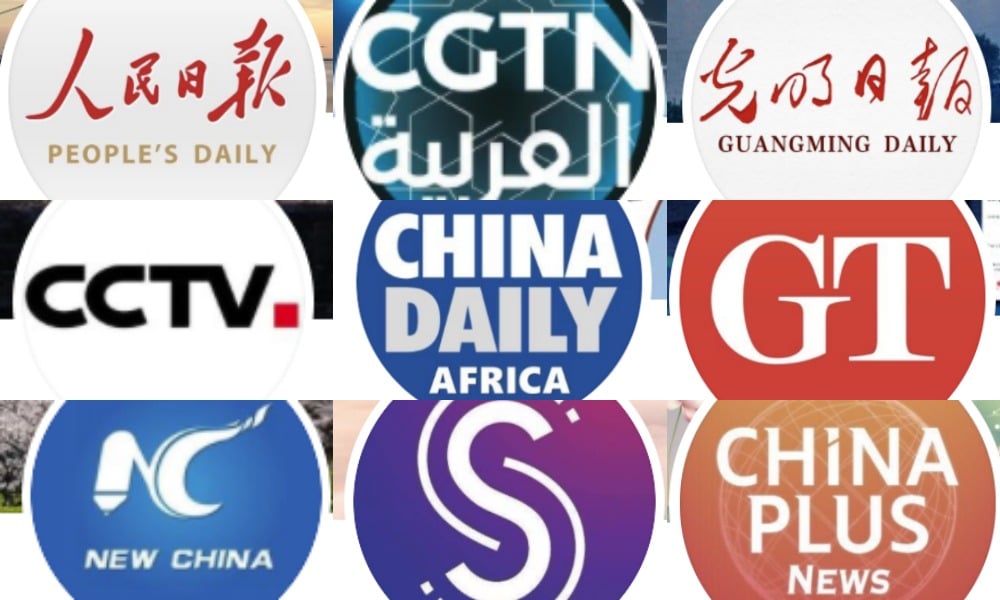
CGTN
@CGTNOfficial, 13.9M followers
VERIFIED ACCOUNT (Joined Jan 2013)
China Xinhua News
@XHNews, 12.6M followers
VERIFIED ACCOUNT (Joined February 2012)
People’s Daily, China
@PDChina, 7.1M followers
VERIFIED ACCOUNT (Joined May 2011)
China Daily
@ChinaDaily, 4.3M followers
VERIFIED ACCOUNT (Joined Nov 2009)
*(Wang Hao, @hongfenghuang
Deputy editor-in-chief of China Daily, 8811 followers
VERIFIED ACCOUNT (Joined Sep 2017))
Global Times
@globaltimesnews, 1.8M followers
VERIFIED ACCOUNT (Joined June 2009)
*(Hu Xijin @胡锡进
Editor-in-chief Global Times, 408.3K followers
VERIFIED ACCOUNT (Joined Aug 2014))
New China 中文
@XinhuaChinese, 1.3M followers
VERIFIED ACCOUNT (Joined Aug 2015)
China.org.cn
@chinaorgcn, 1.1M followers
(Joined May 2010)
*(Xiaohui Wang 王晓辉 @wangxh65
Editor-in-Chief of http://China.org.cn., 1194 followers
(Joined April 2020))
CCTV
@CCTV, 1M followers
VERIFIED ACCOUNT (Joined July 2009)
CGTN Français
@CGTNFrancais, 1M followers
VERIFIED ACCOUNT (Joined Aug 2013)
China Science
@ChinaScience, 1M followers
VERIFIED ACCOUNT (Joined Aug 2019)
Modern China
@PDChinaBusiness, 931.8K followers
VERIFIED ACCOUNT (Joined Aug 2019)
Beautiful China
@PDChinaLife, 870.1K followers
VERIFIED ACCOUNT (Joined Aug 2019)
China Plus News
@ChinaPlusNews, 771.8K followers
VERIFIED ACCOUNT (Joined April 2009)
People’s Daily 人民日報
@PDChinese, 753.3K followers
VERIFIED ACCOUNT (Joined June 2013)
CGTN Arabic
@cgtnarabic, 692.3K followers
VERIFIED ACCOUNT (Joined Dec 2016)
Xinhua Sports
@XHSports, 656K followers
VERIFIED ACCOUNT (Joined May 2016)
China News 中国新闻网
@Echinanews, 649.9K followers
VERIFIED ACCOUNT (Joined July 2011)
CGTN en Español
@cgtnenespanol, 604.6K followers
VERIFIED ACCOUNT (Joined Aug 2016)
Xinhua Culture&Travel
@XinhuaTravel, 545k followers
VERIFIED ACCOUNT (Joined Feb 2019)
China News Service 中國新聞社
@CNS1952, 486.2K followers
VERIFIED ACCOUNT (Joined July 2013)
FlyOverChina
@FlyOverChina, 448.2K followers
VERIFIED ACCOUNT (Joined March 2019)
SHINE (Shanghai United Media Group)
@shanghaidaily, 415.9K followers
VERIFIED ACCOUNT (Joined January 2009)
CGTN America
@cgtnamerica, 289.1K followers
VERIFIED ACCOUNT (Joined June 2012)
Yicai Global 第一财经 (Financial news arm of Shanghai Media Group)
@yicaichina, 263,2K followers
VERIFIED ACCOUNT (Joined March 2016)
Guangming Daily
@Guangming_Daily, 238.6K followers
VERIFIED ACCOUNT (Joined June 2012)
Pueblo En Línea /Spanish version of People’s Daily Online
@PuebloEnLnea, 150K followers
(Joined Dec 2012)
CGTN Africa
@cgtnafrica, 146.2K followers
VERIFIED ACCOUNT (Joined June 2012)
People’s Daily Arabic صحيفة الشعب اليومية بالعربية
@PeopleArabic, 132.5K followers
(Joined Dec 2012)
China Xinhua Español
@XHespanol, 118.1K followers
VERIFIED ACCOUNT (Joined July 2012)
CPEC Official (China-Pakistan Economic Corridor by CRI)
@CPEC_Official, 102.7K followers
(Joined Jan 2016)
Beijing Review
@BeijingReview, 96.6K followers
VERIFIED ACCOUNT (Joined June 2009)
Quotidien du Peuple
@french_renmin, 86.7K followers
(Joined Aug 2011)
CRI Français
@CriFrancais, 77K followers
(Joined Jan 2016)
Sixth Tone (Shanghai United Media Group)
@sixthtone, 75.6K followers
VERIFIED ACCOUNT (Joined Feb 2016)
China Xinhua News Japanese
@XHJapanese, 61.8K followers
VERIFIED ACCOUNT (Joined March 2015)
Xinhua North America
@XHNorthAmerica, 38.8K followers
VERIFIED ACCOUNT (Joined Dec 2016)
People’s Daily Japanese 人民網日本
@peopledailyJP, 34.3K followers
(Joined May 2011)
ShanghaiEye (SMG: Shanghai Media Group)
@ShanghaiEye, 29.4K followers
VERIFIED ACCOUNT (Joined October 2015)
China Daily Asia
@ChinaDailyAsia, 28.3K followers
(Joined April 2011)
CCTV+
@CCTV_plus, 27.7K followers
(Joined Jan 2015)
Renmin Ribao Online
@RenminDeutsch, 27.4K followers
(Joined May 2014)
China Culture
@Chinacultureorg, 21.8K followers
(Joined Nov 2015)
CRI Japanese CRI日本語
@CRIjpn, 20.5K followers
(Joined Feb 2015)
Qingdao / ChindaDaily
@loveqingdao, 19.7K followers
VERIFIED ACCOUNT (Joined Nov 2016)
Global Times Chinese 环球时报
@GlobalTimes_CN, 18.9K followers
(Joined May 2018)
Chine Nouvelle
@XHChineNouvelle, 17.3K followers
VERIFIED ACCOUNT (Joined July 2014)
Xinhua Myanmar
@XHMyanmar, 13.1K followers
VERIFIED ACCOUNT (Joined Feb 2015)
ChinaXinhuaPortugues
@XHportugues, 12.8K followers
VERIFIED ACCOUNT (Joined Sep 2015)
The Business Source
@GlobalTimesBiz, 12.6K followers
(Joined Feb 2016)
China Daily Europe
@ChinaDailyEU, 10.9K followers
VERIFIED ACCOUNT (Joined May 2011)
*(Chen Weihua 陈卫华, @chenweihua
China Daily EU Bureau Chief, 21.5K followers
VERIFIED ACCOUNT (Joined Nov 2009))
@XHSwahili
@XHSwahili, 9587 followers
(Joined July 2015)
CGTN Europe
@CGTNEurope, 8302 followers
(Joined Dec 2016)
The Paper 澎湃新闻 (Shanghai United Media Group)
@thepapercn, 7725 followers
VERIFIED ACCOUNT (Joined August 2019)
CCTV Arabic
@cctvarabic, 6446 followers
(Joined July 2012)
China Xinhua Deutsch
@XHdeutsch, 5981 followers
VERIFIED ACCOUNT (Joined Sep 2015)
XinhuaRomania
@XHRomania, 5491 followers
VERIFIED ACCOUNT (Joined July 2015)
Global Times Russia
@GlobalTimesRus, 2589 followers
VERIFIED ACCOUNT (Joined Nov 2017)
GTLife
@GlobalTimesLife, 1720 followers
(Joined April 2016)
CGTN World Insight with Tian Wei
@WorldInsight_TW, 1517 followers
(Joined Feb 2017)
Women of China
@womenofchina, 1400 followers
(Joined Jan 2011)
People’s Daily app
@PeoplesDailyapp, 1379 followers
(Joined Feb 2018)
China Daily Hong Kong
@CDHKedition, 1141 followers
(Joined May 2020)
CGTNChina24
@China24Official, 720 followers
(Joined Oct 2019)
China Daily Africa
@CDAfricaNews, 690 followers
(Joined Aug 2016)
China Daily USA
@ChinaDailyUSA, 652 followers
(Joined Sep 2018)
Visual China / ChinaDaily
@CD_visual, 645 followers
(Joined May 2020)
China.org.cn German
@germanchinaorgc, 596 followers
(Joined August 2011)
Xinhua Africa
@xinhua_africa, 568 followers
(Joined April 2012)
China Daily World
@ChinaDailyWorld. 535 followers
(Joined May 2020)
CGTN Global Watch
@GlobalWatchCGTN, 514 followers
(Joined May 2018)
People’s Daily – Hong Kong
@PDChinaHK, 451 followers
(Joined June 2020)
China Daily Life
@ChinaDaily_Life, 418 followers
(Joined May 2020)
CGTN Culture
@CGTN_Culture, 362 followers
(Joined Oct 2019)
CGTN Tech
@CGTNTech, 286 followers
(Joined Dec 2018)
CGTN Stories
@CGTNStories, 267 followers
(Joined November 2019)
China Daily Opinion
@CdOpinion, 254 followers
(Joined May 2020)
CGTN Sports
CGTNSports, 183 followers
(Joined Dec 2016)
China Daily Asia-Pacific 中國日報亞太
@Chinadaily_CH, 153 followers
(Joined May 2020)
China Daily Russia
@chinadailyrus, 131 followers
(Joined April 2020)
China Daily EU
@ChinaDaily_EU, 104 followers
(Joined Feb 2019)
China Youth Daily
@ChinaYouthOL, 69 followers
(Joined Sep 2019)
By Manya Koetse
Follow @whatsonweibo
Do you find this kind of research insightful? Would you like to read more about trends in China and its online media? Please consider supporting What’s on Weibo here so we can keep writing articles such as this one. Your small donation makes a big impact.
This is original work by What’s on Weibo, please do not copy, reproduce this content, nor distribute any part of this content over any network.
References
-
-
- Bolsover, Gillian, and Philip Howard. 2019. “Chinese computational propaganda: automation, algorithms and the manipulation of information about Chinese politics on Twitter and Weibo.” Information, Communication & Society, 22:14, 2063-2080.
- Guo, Lei, Kate Mays & Jianing Wang. 2019. “Whose Story Wins on Twitter?” Journalism Studies 20:4, 563-584.
- Mantesso, Sean and Christina Zhou. 2019. “China’s multi-billion-dollar media campaign ‘a major threat for democracies’ around the world.” ABC News, Feb 7 https://www.abc.net.au/news/2019-02-08/chinas-foreign-media-push-a-major-threat-to-democracies/10733068 [July 17, 2020].
- Mozur, Paul. 2019. “Twitter Users in China Face Detention and Threats in New Beijing Crackdown.” The New York Times, Jan 10 https://www.nytimes.com/2019/01/10/business/china-twitter-censorship-online.html [July 11, 2020].
- Nakashima, Ellen, Elizabeth Dwoskin, and Anna Field. 2020. “Twitter removes more than 23,000 accounts it says are linked to China’s Communist Party,” Washington Post, June 11 https://www.washingtonpost.com/world/asia_pacific/twitter-removes-almost-25000-accounts-it-says-are-linked-to-chinas-communist-party/2020/06/11/8c9ec770-aa38-11ea-a43b-be9f6494a87d_story.html [July 10, 2020].
- Shambaugh, David. 2020. “China’s Long March to Global Power,” in China and the World, edited by David Shambaugh, 3-25. New York: Oxford University Press.
- Twitter Safety. 2020. “Disclosing networks of state-linked information operations we’ve removed,” Twitter Safety Blog, June 12 https://blog.twitter.com/en_us/topics/company/2020/information-operations-june-2020.html [July 16 2020].
-
Spotted a mistake or want to add something? Please let us know in comments below or email us.
©2020 Whatsonweibo. All rights reserved. Do not reproduce our content without permission – you can contact us at info@whatsonweibo.com
Manya Koetse is the founder and editor-in-chief of whatsonweibo.com. She is a writer, public speaker, and researcher (Sinologist, MPhil) on social trends, digital developments, and new media in an ever-changing China, with a focus on Chinese society, pop culture, and gender issues. She shares her love for hotpot on hotpotambassador.com. Contact at manya@whatsonweibo.com, or follow on Twitter.

Backgrounder
“Oppenheimer” in China: Highlighting the Story of Qian Xuesen
Qian Xuesen is a renowned Chinese scientist whose life shares remarkable parallels with Oppenheimer’s.
Published
10 months agoon
September 16, 2023By
Zilan Qian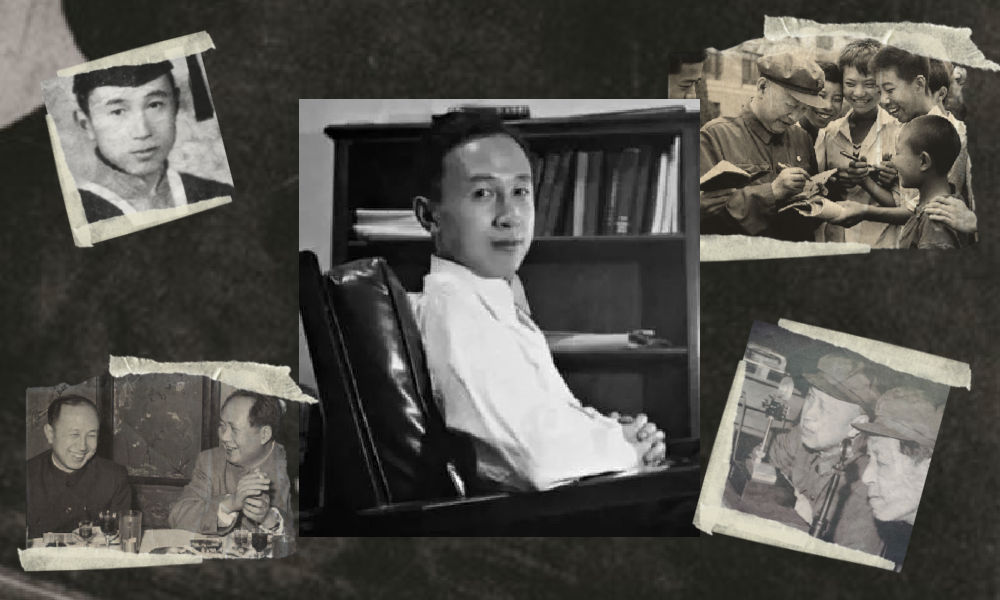
They shared the same campus, lived in the same era, and both played pivotal roles in shaping modern history while navigating the intricate interplay between science and politics. With the release of the “Oppenheimer” movie in China, the renowned Chinese scientist Qian Xuesen is being compared to the American J. Robert Oppenheimer.
In late August, the highly anticipated U.S. movie Oppenheimer finally premiered in China, shedding light on the life of the famous American theoretical physicist J. Robert Oppenheimer (1904-1967).
Besides igniting discussions about the life of this prominent scientist, the film has also reignited domestic media and public interest in Chinese scientists connected to Oppenheimer and nuclear physics.
There is one Chinese scientist whose life shares remarkable parallels with Oppenheimer’s. This is aerospace engineer and cyberneticist Qian Xuesen (钱学森, 1911-2009). Like Oppenheimer, he pursued his postgraduate studies overseas, taught at Caltech, and played a pivotal role during World War II for the US.
Qian Xuesen is so widely recognized in China that whenever I introduce myself there, I often clarify my last name by saying, “it’s the same Qian as Qian Xuesen’s,” to ensure that people get my name.
Some Chinese blogs recently compared the academic paths and scholarly contributions of the two scientists, while others highlighted the similarities in their political challenges, including the revocation of their security clearances.
The era of McCarthyism in the United States cast a shadow over Qian’s career, and, similar to Oppenheimer, he was branded as a “communist suspect.” Eventually, these political pressures forced him to return to China.
Although Qian’s return to China made his later life different from Oppenheimer’s, both scientists lived their lives navigating the complex dynamics between science and politics. Here, we provide a brief overview of the life and accomplishments of Qian Xuesen.
Departing: Going to America
Qian Xuesen (钱学森, also written as Hsue-Shen Tsien), often referred to as the “father of China’s missile and space program,” was born in Shanghai in 1911,1 a pivotal year marked by a historic revolution that brought an end to the imperial dynasty and gave rise to the Republic of China.
Much like Oppenheimer, who pursued further studies at Cambridge after completing his undergraduate education, Qian embarked on a journey to the United States following his bachelor’s studies at National Chiao Tung University (now Shanghai Jiao Tong University). He spent a year at Tsinghua University in preparation for his departure.
The year was 1935, during the eighth year of the Chinese Civil War and the fourth year of Japan’s invasion of China, setting the backdrop for his academic pursuits in a turbulent era.

Qian in his office at Caltech (image source).
One year after arriving in the U.S., Qian earned his master’s degree in aeronautical engineering from the Massachusetts Institute of Technology (MIT). Three years later, in 1939, the 27-year-old Qian Xuesen completed his PhD at the California Institute of Technology (Caltech), the very institution where Oppenheimer had been welcomed in 1927. In 1943, Qian solidified his position in academia as an associate professor at Caltech. While at Caltech, Qian helped found NASA’s Jet Propulsion Laboratory.
When World War II began, while Oppenheimer was overseeing the Manhattan Project’s efforts to assist the U.S. in developing the atomic bomb, Qian actively supported the U.S. government. He served on the U.S. government’s Scientific Advisory Board and attained the rank of lieutenant colonel.

The first meeting of the US Department of the Air Force Scientific Advisory Board in 1946. The predecessor, the Scientific Advisory Group, was founded in 1944 to evaluate the aeronautical programs and facilities of the Axis powers of World War II. Qian can be seen standing in the back, the second on the left (image source).
After the war, Qian went to teach at MIT and returned to Caltech as a full-time professor in 1949. During that same year, Mao Zedong proclaimed the establishment of the People’s Republic of China (PRC). Just one year later, the newly-formed nation became involved in the Korean War, and China fought a bloody battle against the United States.
Red Scare: Being Labeled as a Communist
Robert Oppenheimer and Qian Xuesen both had an interest in Communism even prior to World War II, attending communist gatherings and showing sympathy towards the Communist cause.
Qian and Oppenheimer may have briefly met each other through their shared involvement in communist activities. During his time at Caltech, Qian secretly attended meetings with Frank Oppenheimer, the brother of J. Robert Oppenheimer (Monk 2013).
However, it was only after the war that their political leanings became a focal point for the FBI.
Just as the FBI accused Oppenheimer of being an agent of the Soviet Union, they quickly labeled Qian as a subversive communist, largely due to his Chinese heritage. While the government did not succeed in proving that Qian had communist ties with China during that period, they did ultimately succeed in portraying Qian as a communist affiliated with China a decade later.
During the transition from the 1940s to the 1950s, the Cold War was underway, and the anti-communist witch-hunts associated with the McCarthy era started to intensify (BBC 2020).
In 1950, the Korean War erupted, with the People’s Republic of China (PRC) joining North Korea in the conflict against South Korea, which received support from the United States. It was during this tumultuous period that the FBI officially accused Qian of communist sympathies in 1950, leading to the revocation of his security clearance despite objections from Qian’s colleagues. Four years later, in 1954, Robert Oppenheimer went through a similar process.

The 1950’s security hearing of Qian (second left). (Image source).
After losing his security clearance, Qian began to pack up, saying he wanted to visit his aging parents back home. Federal agents seized his luggage, which they claimed contained classified materials, and arrested him on suspicion of subversive activity. Although Qian denied any Communist leanings and rejected the accusation, he was detained by the government in California and spent the next five years under house arrest.
Five years later, in 1955, two years after the end of the Korean War, Qian was sent home to China as part of an apparent exchange for 11 American airmen who had been captured during the war. He told waiting reporters he “would never step foot in America again,” and he kept his promise (BBC 2020).
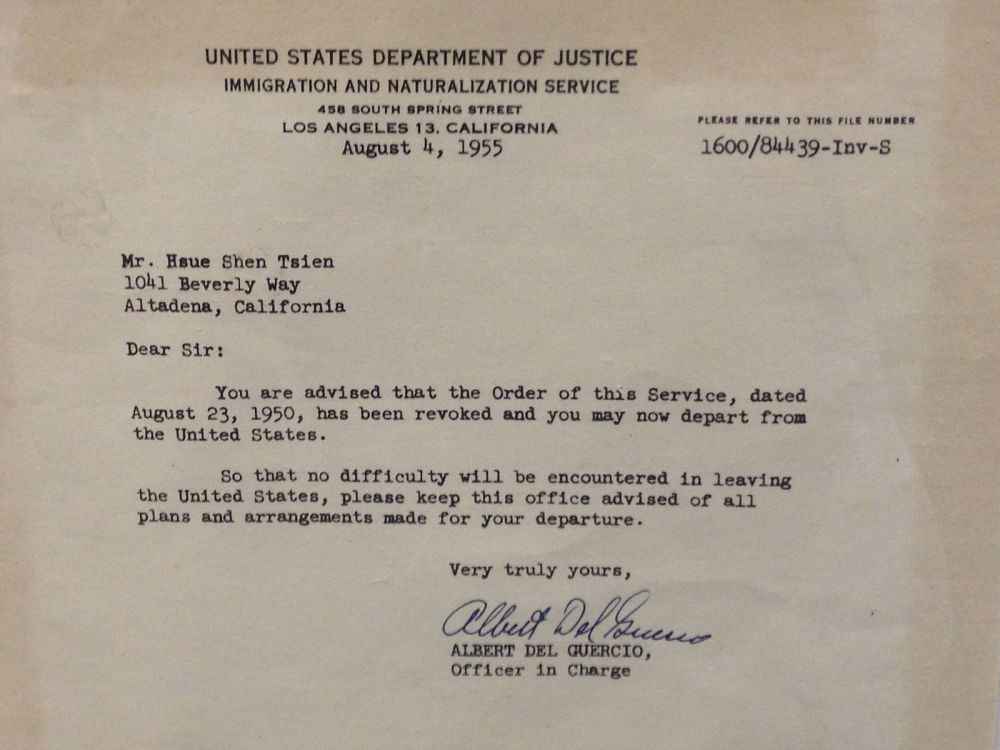
A letter from the US Immigration and Naturalization Service to Qian Xuesen, dated August 4, 1955, in which he was notified he was allowed to leave the US. The original copy is owned by Qian Xuesen Library of Shanghai Jiao Tong University, where the photo was taken. (Caption and image via wiki).
Dan Kimball, who was the Secretary of the US Navy at the time, expressed his regret about Qian’s departure, reportedly stating, “I’d rather shoot him dead than let him leave America. Wherever he goes, he equals five divisions.” He also stated: “It was the stupidest thing this country ever did. He was no more a communist than I was, and we forced him to go” (Perrett & Bradley, 2008).
Kimball may have foreseen the unfolding events accurately. After his return to China, Qian did indeed assume a pivotal role in enhancing China’s military capabilities, possibly surpassing the potency of five divisions. The missile programme that Qian helped develop in China resulted in weapons which were then fired back on America, including during the 1991 Gulf War (BBC 2020).
Returning: Becoming a National Hero
The China that Qian Xuesen had left behind was an entirely different China than the one he returned to. China, although having relatively few experts in the field, was embracing new possibilities and technologies related to rocketry and space exploration.
Within less than a month of his arrival, Qian was welcomed by the then Vice Prime Minister Chen Yi, and just four months later, he had the honor of meeting Chairman Mao himself.
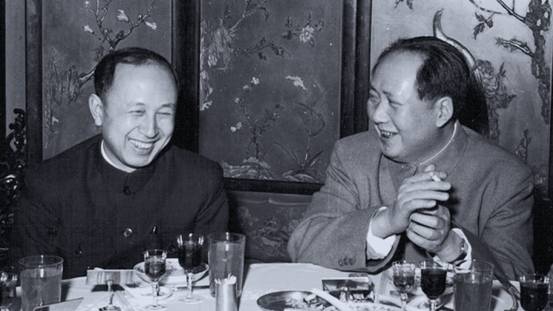
Qian and Mao (image source).
In China, Qian began a remarkably successful career in rocket science, with great support from the state. He not only assumed leadership but also earned the distinguished title of the “father” of the Chinese missile program, instrumental in equipping China with Dongfeng ballistic missiles, Silkworm anti-ship missiles, and Long March space rockets.
Additionally, his efforts laid the foundation for China’s contemporary surveillance system.
By now, Qian has become somewhat of a folk hero. His tale of returning to China despite being thwarted by the U.S. government has become like a legendary narrative in China: driven by unwavering patriotism, he willingly abandoned his overseas success, surmounted formidable challenges, and dedicated himself to his motherland.
Throughout his lifetime, Qian received numerous state medals in recognition of his work, establishing him as a nationally celebrated intellectual. From 1989 to 2001, the state-launched public movement “Learn from Qian Xuesen” was promoted throughout the country, and by 2001, when Qian turned 90, the national praise for him was on a similar level as that for Deng Xiaoping in the decade prior (Wang 2011).
Qian Xuesen remains a celebrated figure. On September 3rd of this year, a new “Qian Xuesen School” was established in Wenzhou, Zhejiang Province, becoming the sixth high school bearing the scientist’s name since the founding of the first one only a year ago.

In 2017, the play “Qian Xuesen” was performed at Qian’s alma mater, Shanghai Jiaotong University. (Image source.)
Qian Xuesen’s legacy extends well beyond educational institutions. His name frequently appears in the media, including online articles, books, and other publications. There is the Qian Xuesen Library and a museum in Shanghai, containing over 70,000 artefacts related to him. Qian’s life story has also been the inspiration for a theater production and a 2012 movie titled Hsue-Shen Tsien (钱学森).2
Unanswered Questions
As is often the case when people are turned into heroes, some part of the stories are left behind while others are highlighted. This holds true for both Robert Oppenheimer and Qian Xuesen.
The Communist Party of China hailed Qian as a folk hero, aligning with their vision of a strong, patriotic nation. Many Chinese narratives avoid the debate over whether Qian’s return was linked to problems and accusations in the U.S., rather than genuine loyalty to his homeland.
In contrast, some international media have depicted Qian as a “political opportunist” who returned to China due to disillusionment with the U.S., also highlighting his criticism of “revisionist” colleagues during the Cultural Revolution and his denunciation of the 1989 student demonstrations.
Unlike the image of a resolute loyalist favored by the Chinese public, Qian’s political ideology was, in fact, not consistently aligned, and there were instances where he may have prioritized opportunity over loyalty at different stages of his life.
Qian also did not necessarily aspire to be a “flawless hero.” Upon returning to China, he declined all offers to have his biography written for him and refrained from sharing personal information with the media. Consequently, very little is known about his personal life, leaving many questions about the motivations driving him, and his true political inclinations.

The marriage photo of Qian and Jiang. (Image source).
We do know that Qian’s wife, Jiang Ying (蒋英), had a remarkable background. She was of Chinese-Japanese mixed race and was the daughter of a prominent military strategist associated with Chiang Kai-shek. Jiang Ying was also an accomplished opera singer and later became a professor of music and opera at the Central Conservatory of Music in Beijing.
Just as with Qian, there remain numerous unanswered questions surrounding Oppenheimer, including the extent of his communist sympathies and whether these sympathies indirectly assisted the Soviet Union during the Cold War.
Perhaps both scientists never imagined they would face these questions when they first decided to study physics. After all, they were scientists, not the heroes that some narratives portray them to be.
Also read:
■ Farewell to a Self-Taught Master: Remembering China’s Colorful, Bold, and Iconic Artist Huang Yongyu
■ “His Name Was Mao Anying”: Renewed Remembrance of Mao Zedong’s Son on Chinese Social Media
By Zilan Qian
Follow @whatsonweibo
1 Some sources claim that Qian was born in Hangzhou, while others say he was born in Shanghai with ancestral roots in Hangzhou.
2The Chinese character 钱 is typically romanized as “Qian” in Pinyin. However, “Tsien” is a romanization in Wu Chinese, which corresponds to the dialect spoken in the region where Qian Xuesen and his family have ancestral roots.
This article has been edited for clarity by Manya Koetse
References (other sources hyperlinked in text)
BBC. 2020. “Qian Xuesen: The man the US deported – who then helped China into space.” BBC.com, 27 October https://www.bbc.com/news/stories-54695598 [9.16.23].
Monk, Ray. 2013. Robert Oppenheimer: A Life inside the Center, First American Edition. New York: Doubleday.
Perrett, Bradley, and James R. Asker. 2008. “Person of the Year: Qian Xuesen.” Aviation Week and Space Technology 168 (1): 57-61.
Wang, Ning. 2011. “The Making of an Intellectual Hero: Chinese Narratives of Qian Xuesen.” The China Quarterly, 206, 352-371. doi:10.1017/S0305741011000300
Get the story behind the hashtag. Subscribe to What’s on Weibo here to receive our newsletter and get access to our latest articles:
Spotted a mistake or want to add something? Please let us know in comments below or email us. First-time commenters, please be patient – we will have to manually approve your comment before it appears.
©2023 Whatsonweibo. All rights reserved. Do not reproduce our content without permission – you can contact us at info@whatsonweibo.com.
Backgrounder
Farewell to a Self-Taught Master: Remembering China’s Colorful, Bold, and Iconic Artist Huang Yongyu
Renowned Chinese artist and the creator of the ‘Blue Rabbit’ zodiac stamp Huang Yongyu has passed away at the age of 98. “I’m not afraid to die. If I’m dead, you may tickle me and see if I smile.”
Published
1 year agoon
June 15, 2023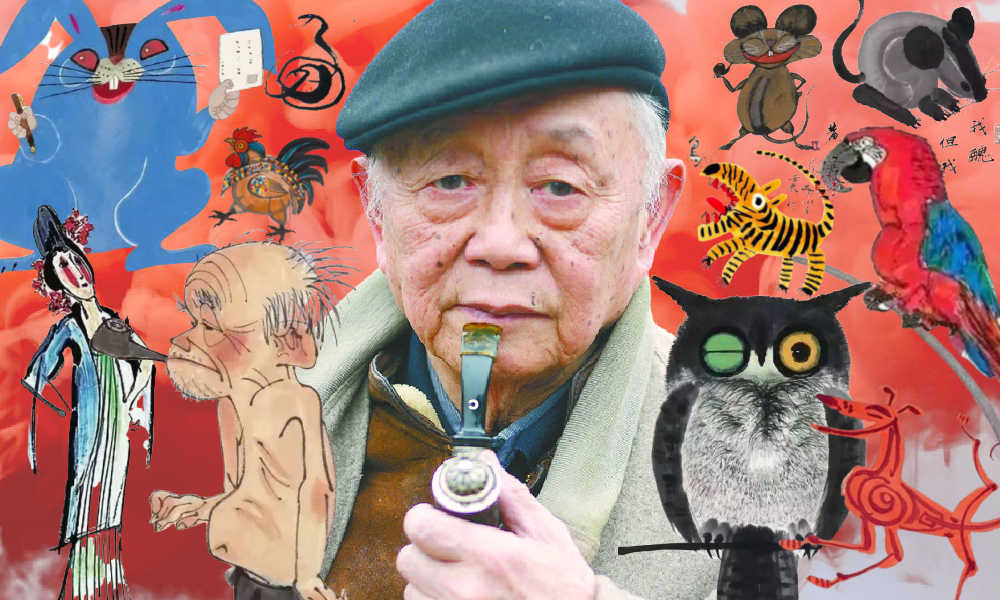
The famous Chinese painter, satirical poet, and cartoonist Huang Yongyu has passed away. Born in 1924, Huang endured war and hardship, yet never lost his zest for life. When his creativity was hindered and his work was suppressed during politically tumultuous times, he remained resilient and increased “the fun of living” by making his world more colorful.
He was a youthful optimist at old age, and will now be remembered as an immortal legend. The renowned Chinese painter and stamp designer Huang Yongyu (黄永玉) passed away on June 13 at the age of 98. His departure garnered significant attention on Chinese social media platforms this week.
On Weibo, the hashtag “Huang Yongyu Passed Away” (#黄永玉逝世#) received over 160 million views by Wednesday evening.
Huang was a member of the China National Academy of Painting (中国国家画院) as well as a Professor at the Central Academy of Fine Arts (中央美术学院).
Huang Yongyu is widely recognized in China for his notable contribution to stamp design, particularly for his iconic creation of the monkey stamp in 1980. Although he designed a second monkey stamp in 2016, the 1980 stamp holds significant historical importance as it marked the commencement of China Post’s annual tradition of releasing zodiac stamps, which have since become highly regarded and collectible items.
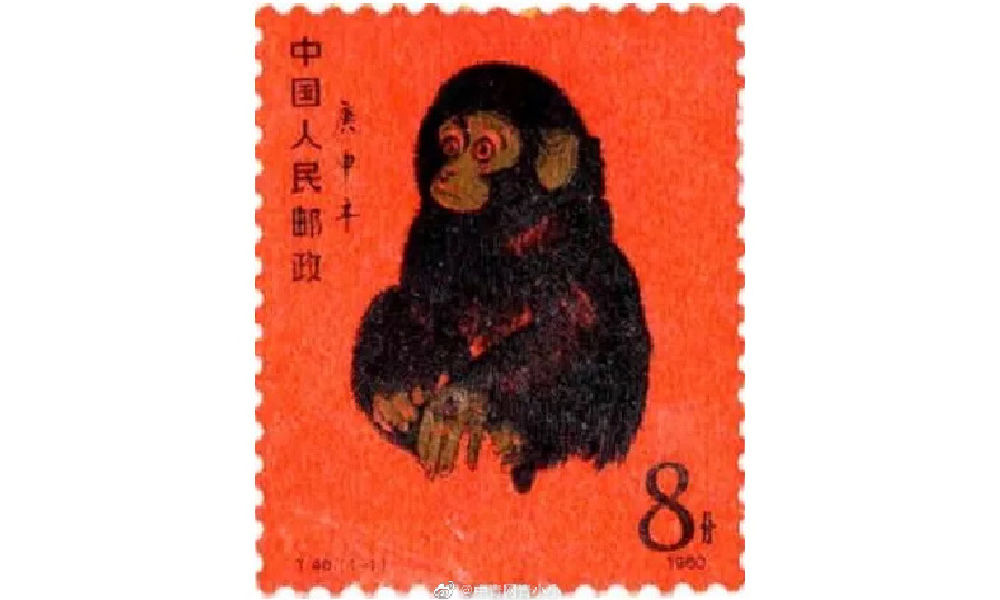
Huang’s famous money stamp that was issued by China Post in 1980.
The monkey stamp designed by Huang Yongyu has become a cherished collector’s item, even outside of China. On online marketplaces like eBay, individual stamps from this series are being sold for approximately $2000 these days.
Huang Yongyu’s latest most famous stamp was this year’s China Post zodiac stamp. The stamp, a blue rabbit with red eyes, caused some online commotion as many people thought it looked “horrific.”
Some thought the red-eyed blue rabbit looked like a rat. Others thought it looked “evil” or “monster-like.” There were also those who wondered if the blue rabbit looked so wild because it just caught Covid.
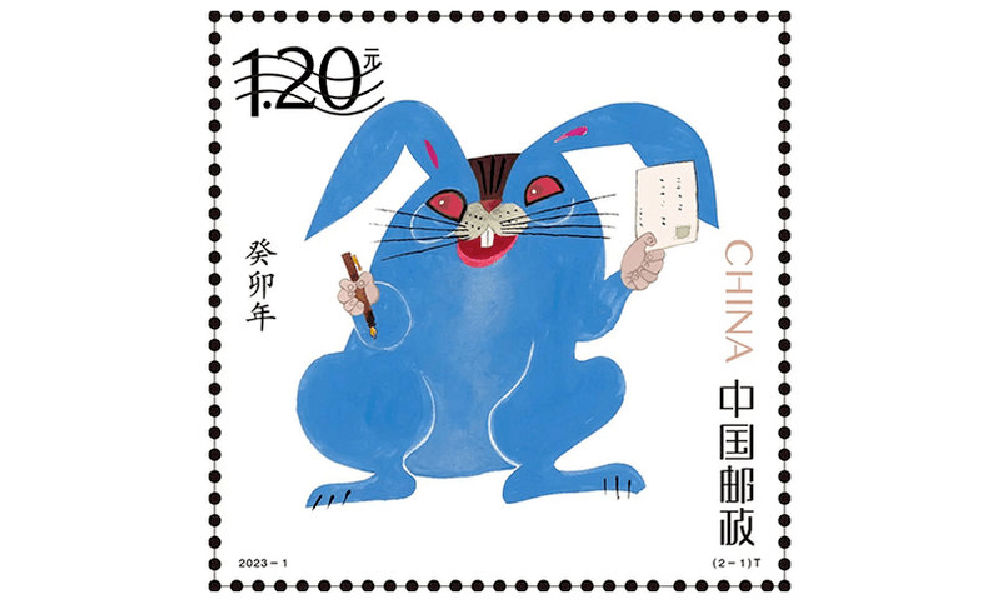
Huang’s (in)famous blue rabbit stamp.
Nevertheless, many people lined up at post offices for the stamps and they immediately sold out.
In light of the controversy, Huang Yongyu spoke about the stamps in a livestream in January of 2023. The 98-year-old artist claimed he had simply drawn the rabbit to spread joy and celebrate the new year, stating, “Painting a rabbit stamp is a happy thing. Everyone could draw my rabbit. It’s not like I’m the only one who can draw this.”
Huang’s response also went viral, with one Weibo hashtag dedicated to the topic receiving over 12 million views (#蓝兔邮票设计者直播回应争议#) at the time. Those defending Huang emphasized how it was precisely his playful, light, and unique approach to art that has made Huang’s work so famous.
A Self-Made Artist
“I’m ugly, but my mum likes me”
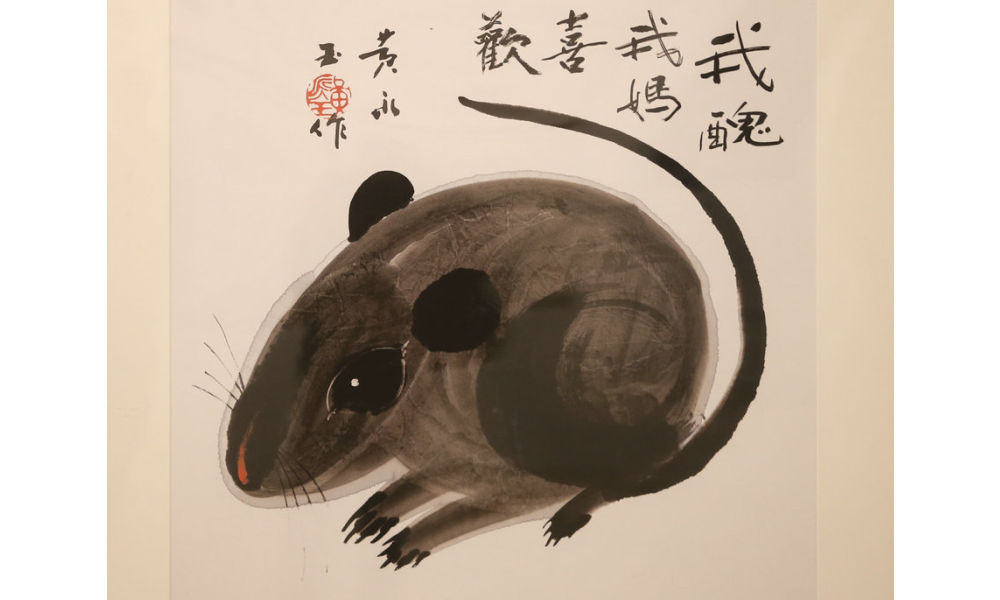
‘Ugly Mouse’ by Huang Yongyu [Image via China Daily].
Huang Yongyu was born on August 9, 1924, in Hunan’s Chengde as a native of the Tujia ethnic group.
He was born into an extraordinary family. His grandfather, Huang Jingming (黄镜铭), worked for Xiong Xiling (熊希齡), who would become the Premier of the Republic of China. His first cousin and lifelong friend was the famous Chinese novelist Shen Congwen (沈从文). Huang’s father studied music and art and was good at drawing and playing the accordion. His mother graduated from the Second Provincial Normal School and was the first woman in her county to cut her hair short and wear a short skirt (CCTV).
Born in times of unrest and poverty, Huang never went to college and was sent away to live with relatives at the age of 13. His father would die shortly after, depriving him of a final goodbye. Huang started working in various places and regions, from porcelain workshops in Dehua to artisans’ spaces in Quanzhou. At the age of 16, Huang was already earning a living as a painter and woodcutter, showcasing his talents and setting the foundation for his future artistic pursuits.
When he was 22, Huang married his first girlfriend Zhang Meixi (张梅溪), a general’s daughter, with whom he shared a love for animals. He confessed his love for her when they both found themselves in a bomb shelter after an air-raid alarm.

Huang and Zhang Meixi [163.com]
In his twenties, Huang Yongyu emerged as a sought-after artist in Hong Kong, where he had relocated in 1948 to evade persecution for his left-wing activities. Despite achieving success there, he heeded Shen Congwen’s advice in 1953 and moved to Beijing. Accompanied by his wife and their 7-month-old child, Huang took on a teaching position at the esteemed Central Academy of Fine Arts (中央美术学院).
The couple raised all kinds of animals at their Beijing home, from dogs and owls to turkeys and sika deers, and even monkeys and bears (Baike).
Throughout Huang’s career, animals played a significant role, not only reflecting his youthful spirit but also serving as vehicles for conveying satirical messages.
One recurring motif in his artwork was the incorporation of mice. In one of his famous works, a grey mouse is accompanied by the phrase ‘I’m ugly, but my mum likes me’ (‘我丑,但我妈喜欢’), reinforcing the notion that regardless of our outward appearance or circumstances, we remain beloved children in the eyes of our mothers.
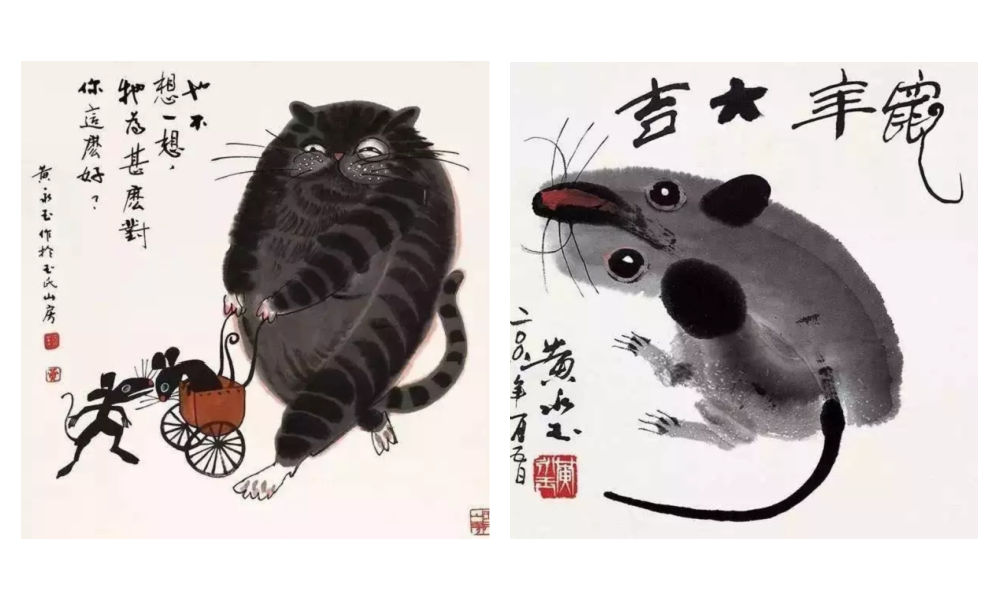
As a teacher, Huang liked to keep his lessons open-minded and he, who refused to join the Party himself, stressed the importance of art over politics. He would hold “no shirt parties” in which his all-male studio students would paint in an atmosphere of openness and camaraderie during hot summer nights (Andrews 1994, 221; Hawks 2017, 99).
By 1962, creativity in the classroom was limited and there were far more restrictions to what could and could not be created, said, and taught.
Bright Colors in Dark Times
“Strengthen my resolve and increase the fun of living”
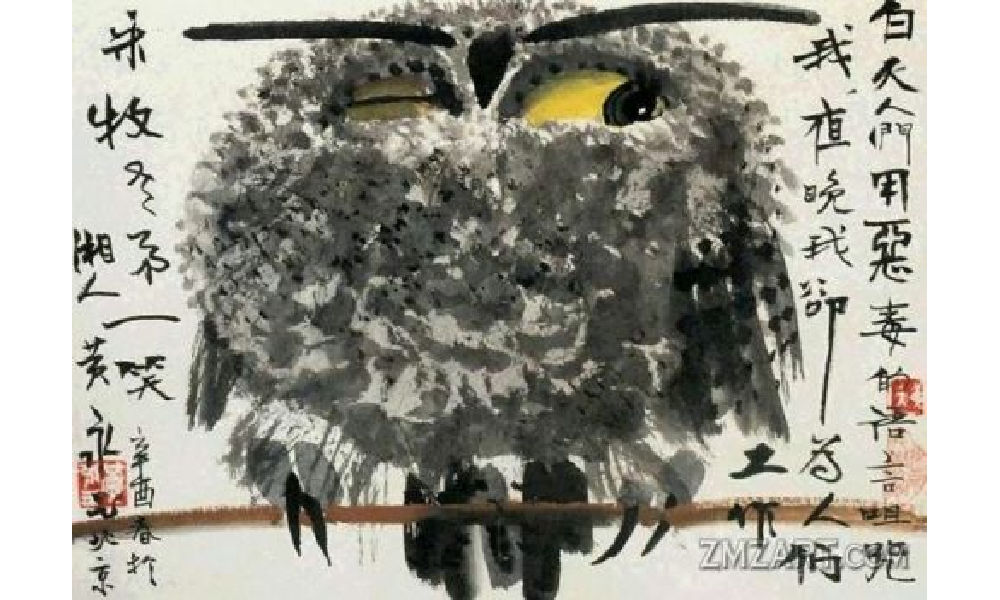
Huang Yongyu’s winking owl, 1973, via Wikiart.
In 1963, Huang was sent to the countryside as part of the “Four Cleanups” movement (四清运动, 1963-1966). Although Huang cooperated with the requirement to attend political meetings and do farm work, he distanced himself from attempts to reform his thinking. In his own time, and even during political meetings, he would continue to compose satirical and humorous pictures and captions centered around animals, which would later turn into his ‘A Can of Worms’ series (Hawks 2017, 99; see Morningsun.org).
Three years later, at the beginning of the Cultural Revolution, many Chinese major artists, including Huang, were detained in makeshift jails called ‘niupeng‘ (牛棚), cowsheds. Huang’s work was declared to be counter-revolutionary, and he was denounced and severely beaten. Despite the difficult circumstances, Huang’s humor and kindness would remind his fellow artist prisoners of the joy of daily living (2017, 95-96).
After his release, Huang and his family were relocated to a cramped room on the outskirts of Beijing. The authorities, thinking they could thwart his artistic pursuits, provided him with a shed that had only one window, which faced a neighbor’s wall. However, this limitation didn’t deter Huang. Instead, he ingeniously utilized vibrant pigments that shone brightly even in the dimly lit space.
During this time, he also decided to make himself an “extra window” by creating an oil painting titled “Eternal Window” (永远的窗户). Huang later explained that the flower blossoms in the paining were also intended to “strengthen my resolve and increase the fun of living” (Hawks 2017, 4; 100-101).

Huang Yongyu’s Eternal Window [Baidu].
In 1973, during the peak of the Cultural Revolution, Huang painted his famous winking owl. The calligraphy next to the owl reads: “During the day people curse me with vile words, but at night I work for them” (“白天人们用恶毒的语言诅咒我,夜晚我为他们工作”) (Matthysen 2021, 165).
The painting was seen as a display of animosity towards the regime, and Huang got in trouble for it. Later on in his career, however, Huang would continue to paint owls. In 1977, when the Cultural Revolution had ended, Huang Yongyu painted other owls to ridicules his former critics (2021, 174).
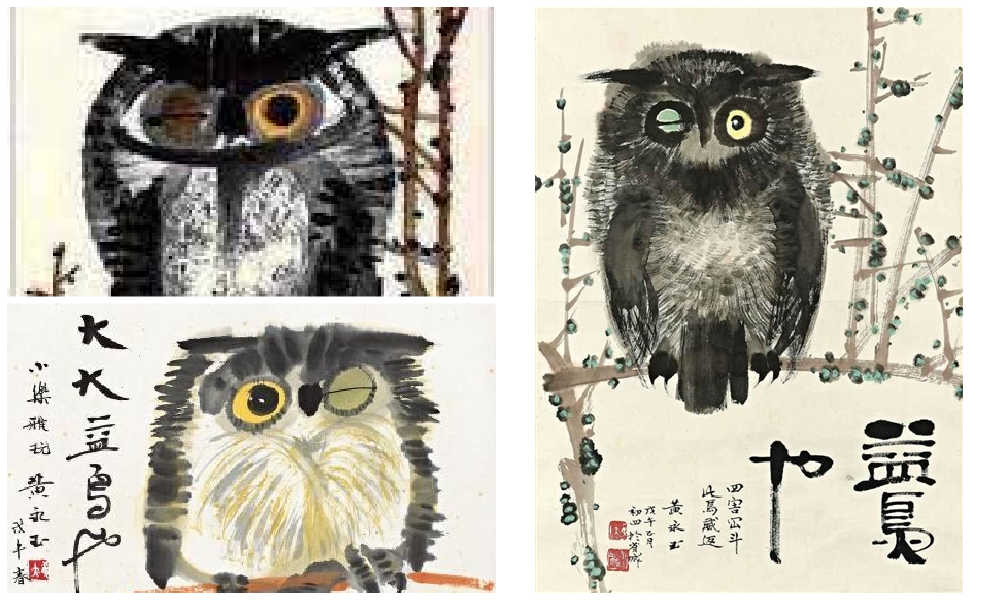
According to art scholar Shelly Drake Hawks, Huang Yongyu employed animals in his artwork to satirize the realities of life under socialism. This approach can be loosely compared to George Orwell’s famous novel Animal Farm.
However, Huang’s artistic style, vibrant personal life, and boundary-pushing work ethic also draw parallels to Picasso. Like Picasso, Huang embraced a colorful life, adopted an innovative approach to art, and challenged artistic norms.
An Optimist Despite All Hardships
“Quickly come praise me, while I’m still alive”

Huang Yongyu will be remembered in China with love and affection for numerous reasons. Whether it is his distinctive artwork, his mischievous smile and trademark pipe, his unwavering determination to follow his own path despite the authorities’ expectations, or his enduring love for his wife of over 75 years, there are countless aspects to appreciate and admire about Huang.
One things that is certainly admirable is how he was able to maintain a youthful and joyful attitude after suffering many hardships and losing so many friends.
“An intriguing soul. Too wonderful to describe,” one Weibo commenter wrote about Huang, sharing pictures of Huang Yongyu’s “Scenes of Pooping” (出恭图) work.
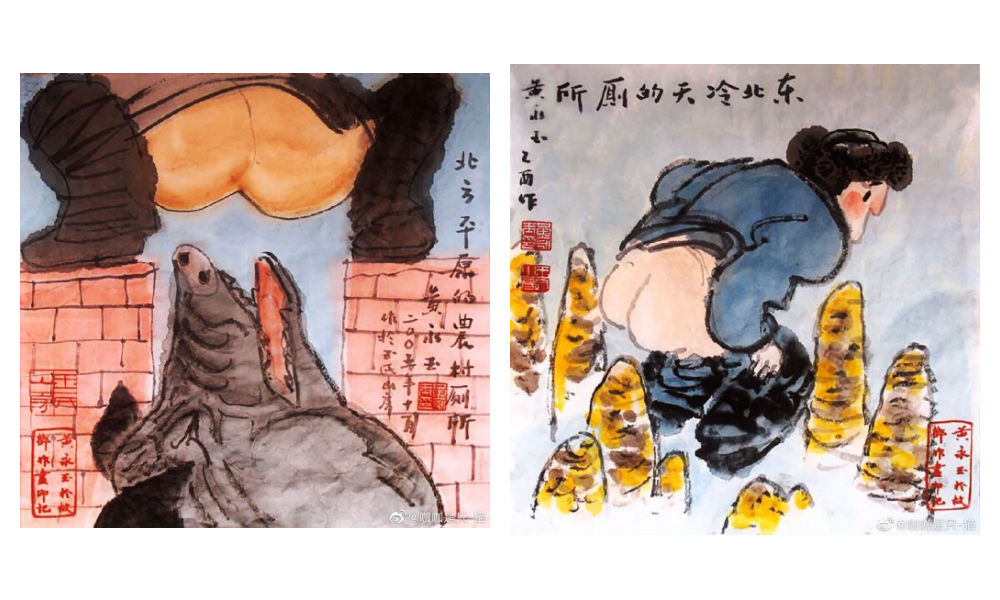
Old age did not hold him back. At the age of 70, his paintings sold for millions. When he was in his eighties, he was featured on the cover of Esquire (时尚先生) magazine.
At the age of 82, he stirred controversy in Hong Kong with his “Adam and Eve” sculpture featuring male and female genitalia, leading to complaints from some viewers. When confronted with the backlash, Huang answered, “I just wanted to have a taste of being sued, and see how the government would react” (Ora Ora).
I'm guessing the 98-year-old Huang loved the controversy. When confronted with backlash for his sculpture featuring male and female genitalia in 2007 Hong Kong, Huang answered, "I just wanted to have a taste of being sued, and see how the government would react." pic.twitter.com/kG0MVVM4SN
— Manya Koetse (@manyapan) June 15, 2023
In his nineties, he started driving a Ferrari. He owned mansions in his hometown in Hunan, in Beijing, in Hong Kong, and in Italy – all designed by himself (Chen 2019).
Huang kept working and creating until the end of his life. “It’s good to work diligently. Your work may be meaningful. Maybe it won’t be. Don’t insist on life being particularly meaningful. If it’s happy and interesting, then that’s great enough.”

“Hometown Scenery” or rather “Hunan Scenery” (湘西风景) by Huang.
Huang did not dread the end of his life.
“My old friends have all died, I’m the only one left,” he said at the age of 95. He wrote his will early and decided he wanted a memorial service for himself before his final departure. “Quickly come praise me, while I’m still alive,” he said, envisioning himself reclining on a chair in the center of the room, “listening to how everyone applauds me” (CCTV, Sohu).
He stated: “I don’t fear death at all. I always joke that when I die, you should tickle me first and see if I’ll smile” (“对死我是一点也不畏惧,我开玩笑,我等死了之后先胳肢我一下,看我笑不笑”).
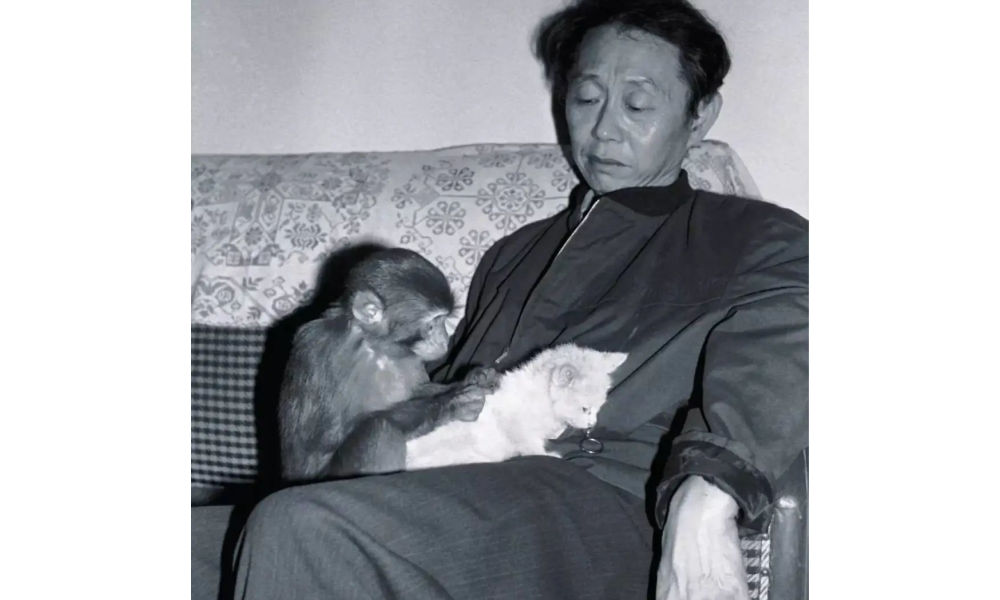
Huang with Yiwo (伊喔), the original model for the monkey stamp [Shanghai Observer].
Huang also was not sentimental about what should happen to his ashes. In a 2019 article in Guangming Daily, it was revealed that he suggested to his wife the idea of pouring his ashes into the toilet and flushing them away with the water.
However, his wife playfully retorted, saying, “No, that won’t do. Your life has been too challenging; you would clog the toilet.”
To this, Huang responded, “Then wrap my ashes into dumplings and let everyone [at the funeral] eat them, so you can tell them, ‘You’ve consumed Huang Yongyu’s ashes!'”
But she also opposed of that idea, saying that they would vomit and curse him forever.
Nevertheless, his wife expressed opposition to this idea, citing concerns that it would cause people to vomit and curse him indefinitely.
In response, Huang declared, “Then let’s forget about my ashes. If you miss me after I’m gone, just look up at the sky and the clouds.” Eventually, his wife would pass away before him, in 2020, at the age of 98, having spent 77 years together with Huang.
Huang will surely be missed. Not just by the loved ones he leaves behind, but also by millions of his fans and admirers in China and beyond.
“We will cherish your memory, Mr. Huang,” one Weibo blogger wrote. Others honor Huang by sharing some of his famous quotes, such as, “Sincerity is more important than skill, which is why birds will always sing better than humans” (“真挚比技巧重要,所以鸟总比人唱得好”).
Among thousands of other comments, another social media user bid farewell to Huang Yongyu: “Our fascinating Master has transcended. He is now a fascinating soul. We will fondly remember you.”
By Manya Koetse
Get the story behind the hashtag. Subscribe to What’s on Weibo here to receive our newsletter and get access to our latest articles:
References
Andrews, Julia Frances. 1994. Painters and Politics in the People’s Republic of China, 1949-1979. Berkley: University of California Press.
Baike. “Huang Yongyu 黄永玉.” Baidu Baike https://baike.baidu.com/item/%E9%BB%84%E6%B0%B8%E7%8E%89/1501951 [June 14, 2023].
CCTV. 2023. “Why Everyone Loves Huang Yongyu [为什么人人都爱黄永玉].” WeChat 央视网 June 14.
Chen Hongbiao 陈洪标. 2019. “Most Spicy Artist: Featured in a Magazine at 80, Flirting with Lin Qingxia at 91, Playing with Cars at 95, Wants Memorial Service While Still Alive [最骚画家:80岁上杂志,91岁撩林青霞,95岁玩车,活着想开追悼会].” Sohu/Guangming Daily March 16: https://www.sohu.com/a/301686701_819105 [June 15, 2023].
Hawks, Shelley Drake. 2017. The Art of Resistance Painting by Candlelight in Mao’s China. Seattle: University of Washington Press.
Matthysen, Mieke. 2021. Ignorance is Bliss: The Chinese Art of Not Knowing. Palgrave Macmillan.
Ora Ora. “HUANG YONGYU 黃永玉.” Ora Ora https://www.ora-ora.com/artists/103-huang-yongyu/ [June 15, 2023].
Spotted a mistake or want to add something? Please let us know in comments below or email us. First-time commenters, please be patient – we will have to manually approve your comment before it appears.
©2023 Whatsonweibo. All rights reserved. Do not reproduce our content without permission – you can contact us at info@whatsonweibo.com.
Subscribe

Weibo Watch: The Future is Here

“Bye Bye Biden”: Biden’s Many Nicknames in Chinese

Enjoying the ‘Sea’ in Beijing’s Ditan Park

A Triumph for “Comrade Trump”: Chinese Social Media Reactions to Trump Rally Shooting

Weibo Watch: Get Up, Stand Up

The Tragic Story of “Fat Cat”: How a Chinese Gamer’s Suicide Went Viral

“Old Bull Eating Young Grass”: 86-Year-Old Chinese Painter Fan Zeng Marries 36-Year-Old Xu Meng

A Brew of Controversy: Lu Xun and LELECHA’s ‘Smoky’ Oolong Tea

Singing Competition or Patriotic Fight? Hunan TV’s ‘Singer 2024’ Stirs Nationalistic Sentiments

Zara Dress Goes Viral in China for Resemblance to Haidilao Apron

Weibo Watch: The Battle for the Bottom Bed

About the “AI Chatbot Based on Xi Jinping” Story

China’s Intensified Social Media Propaganda: “Taiwan Must Return to Motherland”

Weibo Watch: Telling China’s Stories Wrong

Saying Goodbye to “Uncle Wang”: Wang Wenbin Becomes Chinese Ambassador to Cambodia
Get in touch
Would you like to become a contributor, or do you have any tips or suggestions? Get in touch here!
Popular Reads
-

 China Insight3 months ago
China Insight3 months agoThe Tragic Story of “Fat Cat”: How a Chinese Gamer’s Suicide Went Viral
-

 China Music4 months ago
China Music4 months agoThe Chinese Viral TikTok Song Explained (No, It’s Not About Samsung)
-

 China Digital10 months ago
China Digital10 months agoToo Sexy for Weibo? Online Discussions on the Concept of ‘Cābiān’
-

 China Arts & Entertainment12 months ago
China Arts & Entertainment12 months agoBehind 8 Billion Streams: Who is Dao Lang Cursing in the Chinese Hit Song ‘Luocha Kingdom’?





Carmen
July 21, 2020 at 10:24 pm
“This development is somewhat surprising, as previous studies have found no evidence of these kinds of automated processes on Twitter as part of Chinese international propaganda efforts (Bolsover & Howard 2019). Noteworthy enough, it was previously found that those using bot activities on the platform to manipulate information about China and Chinese politics were actually anti-China groups (ibid., 2076).”
Who did this research lol I’ve found sooooo many pro-ccp accounts on Twitter when the HK issue exploded last time